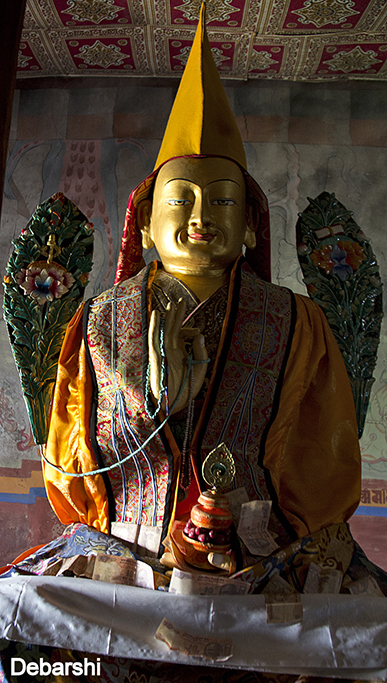Introduction
Debarshi writing on our Road Trips to Ladakh inspired me to write on the Monasteries in Ladakh (the ones we visited). We have driven to Ladakh twice in 2012 to the Zanskar Valley and in 2014 to Nubra & Turtuk.
Ladakh is one of the prime tourist areas in India in the state of Jammu & Kashmir. Buddhist Circuit tourism is becoming rather popular considering the presence of ancient Monasteries in Ladakh.
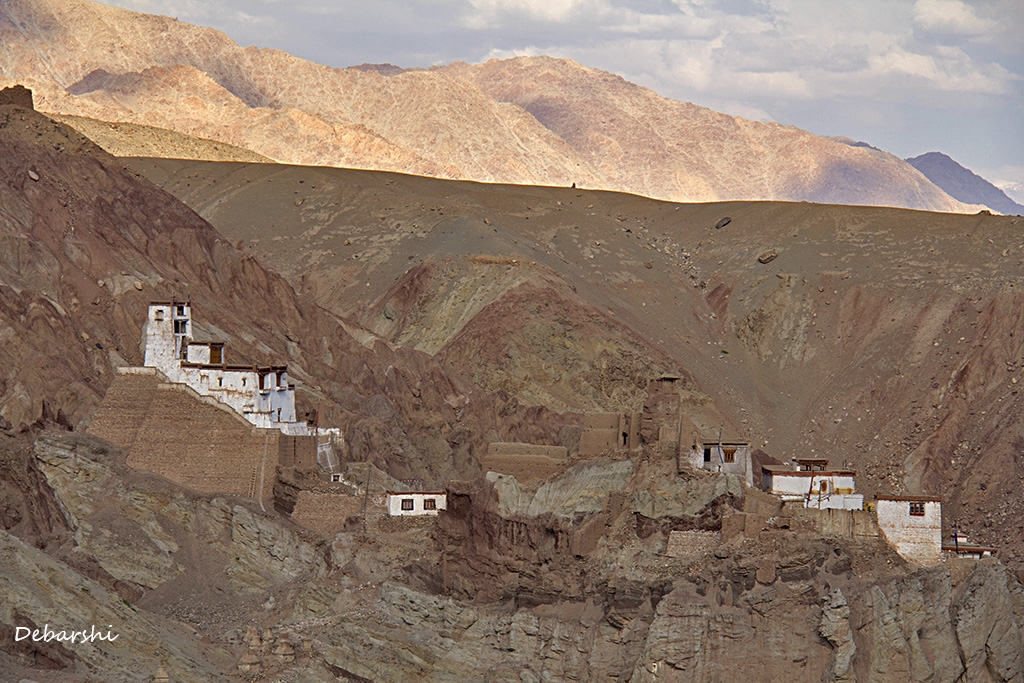
Monasteries in Ladakh – Spread across the beautiful and dramatic landscape
Our experience
Ladakh is home to about 35 or 40 monasteries from the various Buddhist Sects. We did visit some extraordinary monasteries in Ladakh.
All monasteries in Ladakh region are open from 7 or 8 am to sunset with an hour’s lunch break from 1 to 2 pm. In many a monastery, you can also share a bowl of Thukpa (noodle soup) with the monks.
You can also visit the monasteries in ladakh during their annual festivals unforgettable with the lamas invoking sacred chants and also dancing in colorful masks.
Shergol Monastery
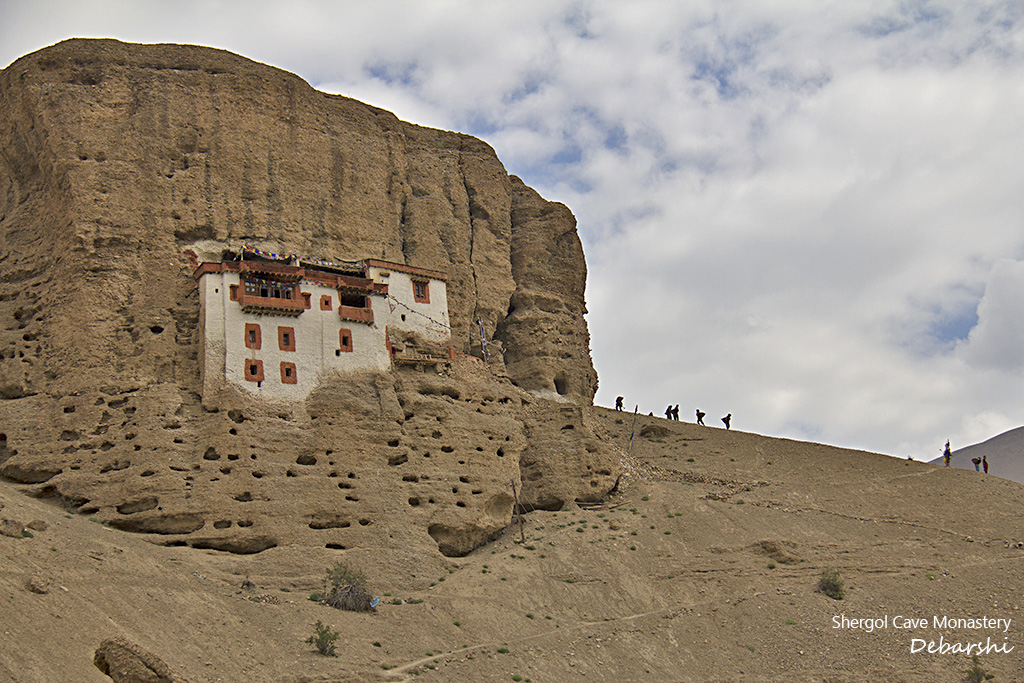
This is a cave monastery about 40 km from Kargil. You have to take a slight detour from the main road across the bridge on the Wakha River. This monastery looks like it is dangling from the tawny brown granite mountain side. There are a few old graceful frescoes in the monastery and you will always get great unusual snaps. The monastery also houses a Buddhist nunnery and is the gateway to Urgyan-Dzong, a meditation retreat in the mountains. In 2014, we also had a flat tire here and repaired that while our friends went up the monastery.
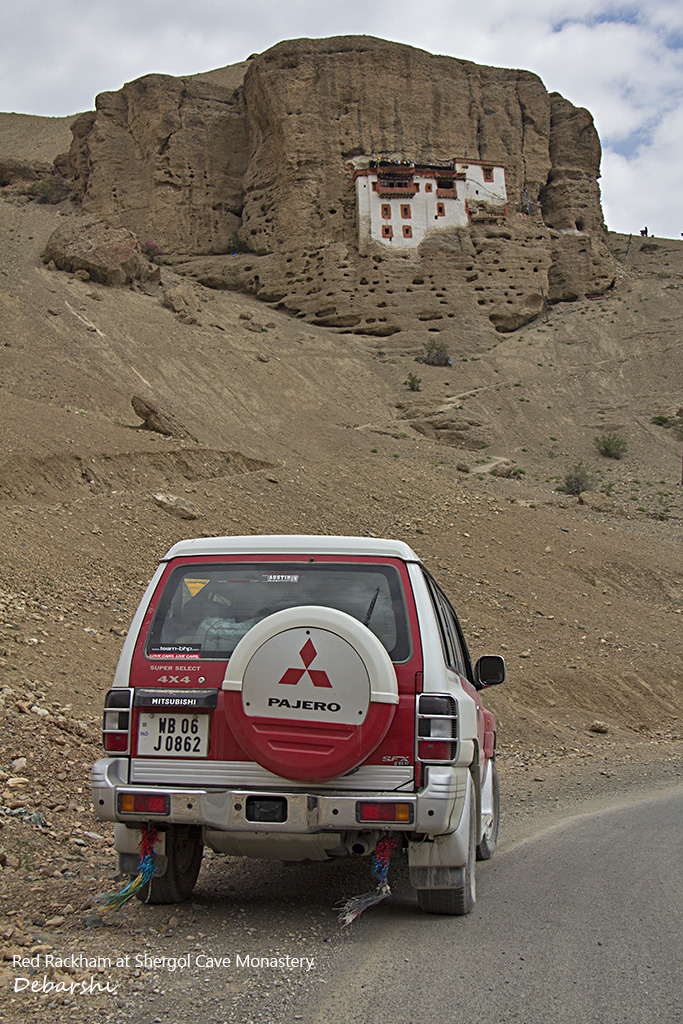
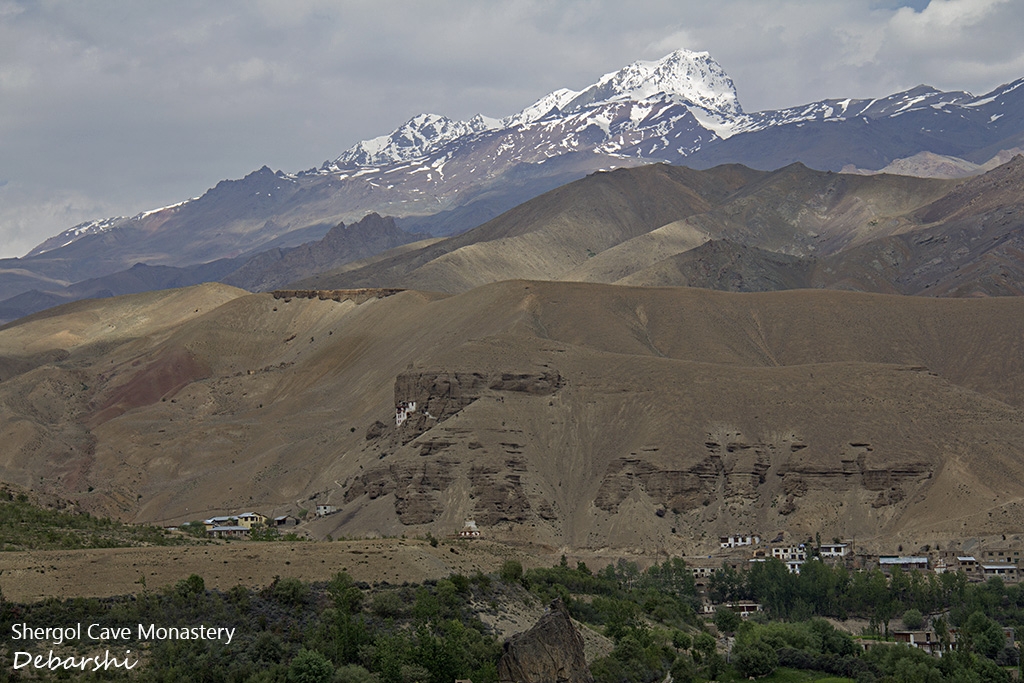
A little ahead, you will also cross the 30 feet high Maitreya Buddha (Future Incarnation) at Mulbekh sculpted on the face of a cliff. This is visible from the highway but partly obscure from the road by a temple.
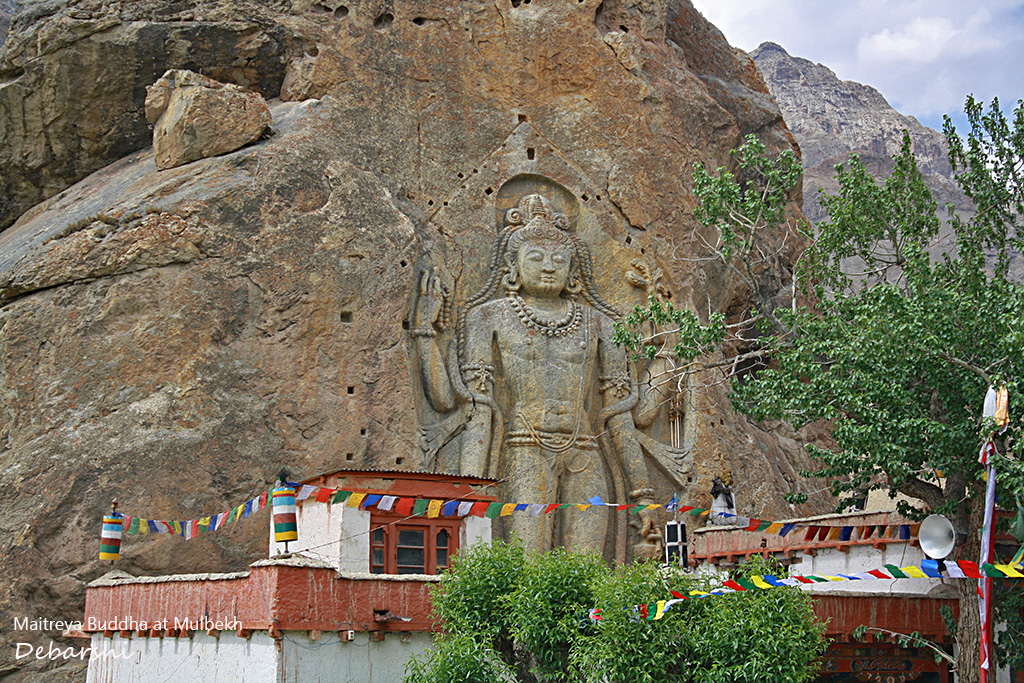
Lamayuru
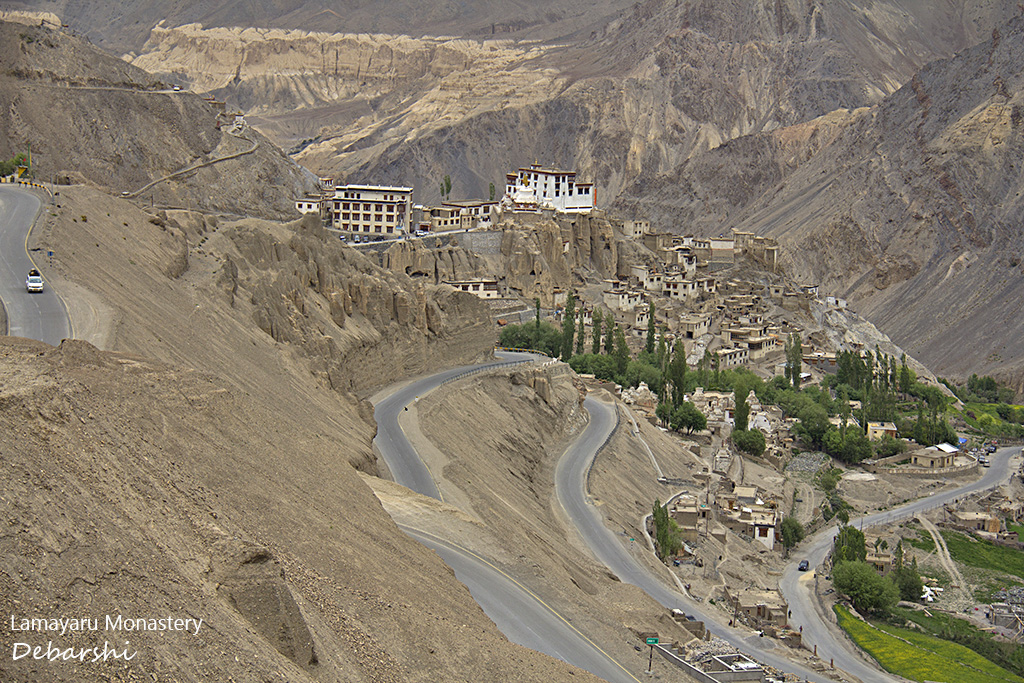
Lamayuru or Yungdrung Tharpaling Monastery is just about 15 km ahead of Fotu La. This is one of the oldest and largest monasteries in Ladakh belonging to the Red Hat (Kadampa) Sect of Buddhism founded sometime in the 11th century. The Lamayuru Monastery has 150 – 300 Buddhist monks registered .
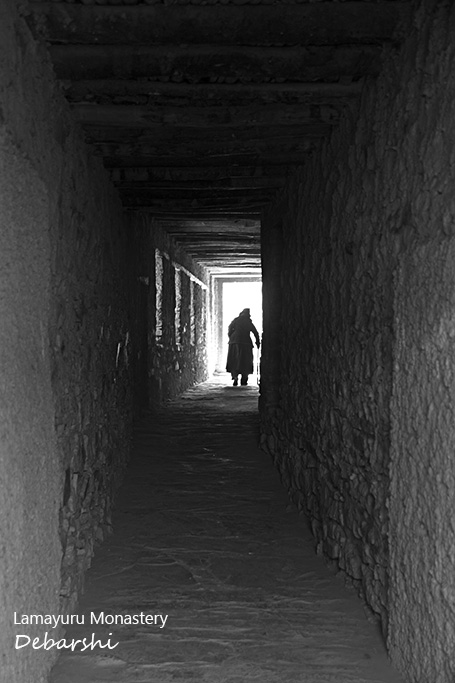
Today you can only see the surviving central Seng-ge-sgang built by the monk Rinchen Zangpo. There is a rich collection of Thangkas of wall hangings and of course the sacred Kangyur and Tengyur manuscripts. We were fortunate to meet the Head Lama. The senior monks used to be trained in DrikungThil monasteries in Tibet before 1959.
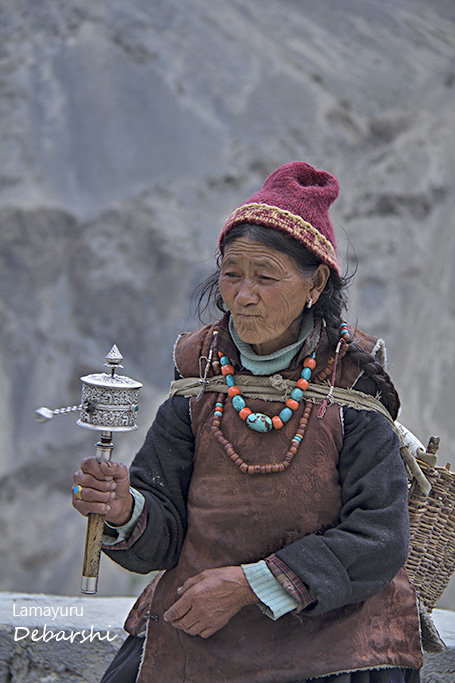
Historically, Lamayuru has been revered not only by Buddhists, but even by other religions. All rulers including the Kashmiri Maliks exempted this monastery from taxes. The monks also dispensed advice and served as negotiators between the Kings of Ladakh and Balti.
Today, the monastery is known for hosting the YuruKabgyat or the masked dance festival held in June or July or August as per the Tibetan Calendar . The dates are in mid June in 2018.
The monastery is open from sunrise to sunset with an hour’s lunch break from 1 to 2 pm .This is also a good place to stop for lunch in the café situated there.
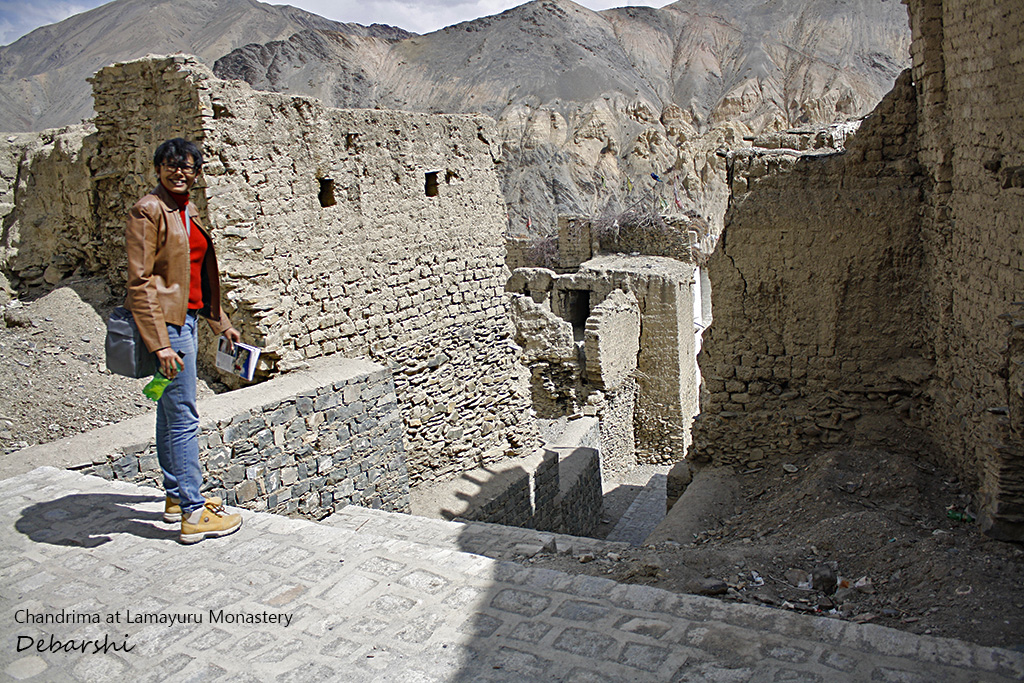
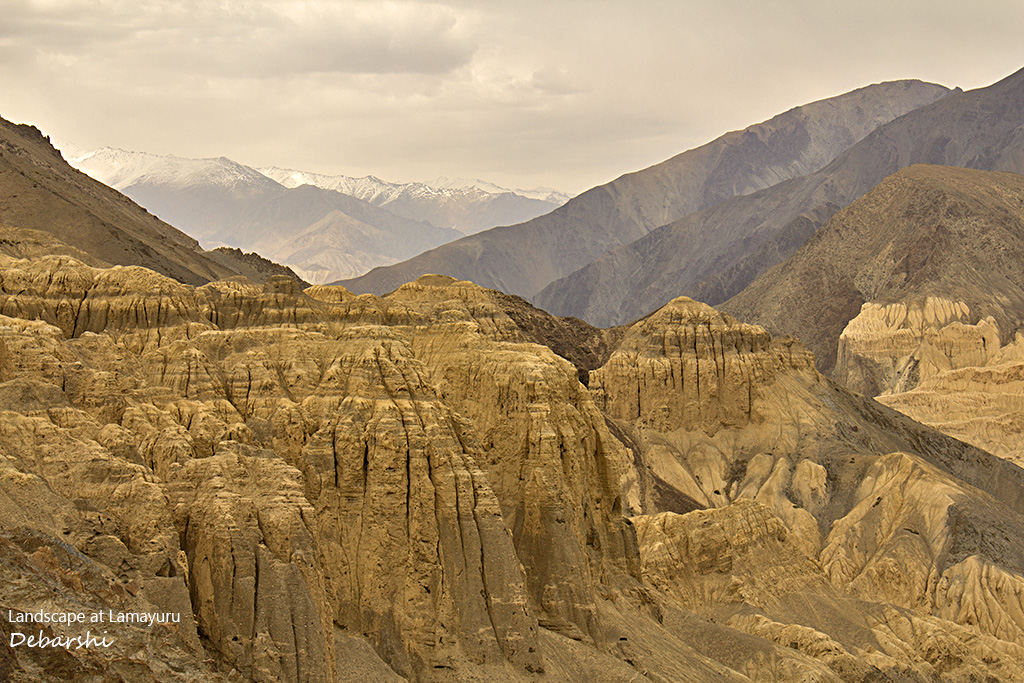
Alchi
Alchi is by far the most captivating monastery I have been to apart from Hemis. It is not just a gompa but a a choskhor, a sacred enclave and a seat of learning.
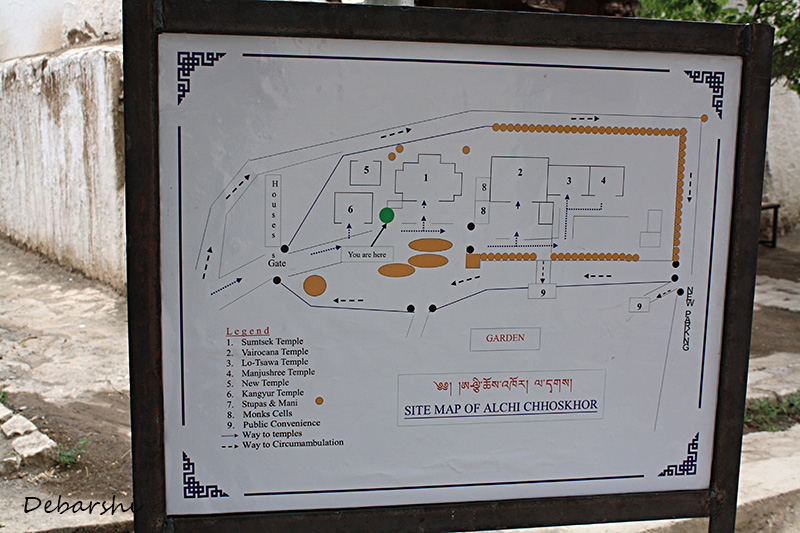
It is probably the oldest estimated to have been built between 958 and 1055 AD also by Rinchen Zangpo.We also did note a stone inscription mentioning that the monastery was built by a Tibetan noble.
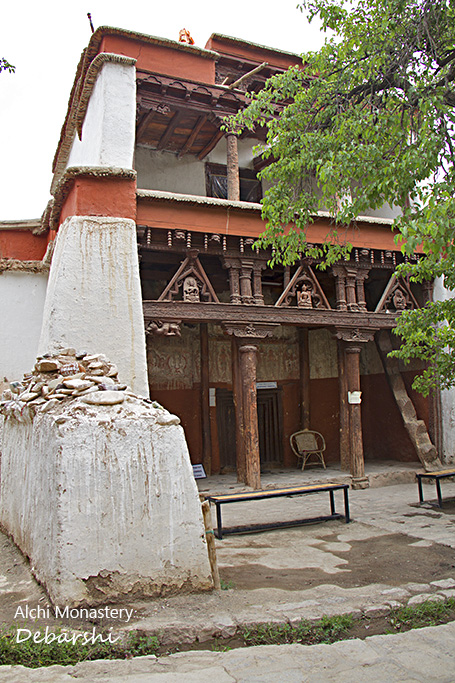
This is about 65 km from Leh on the Kargil – Leh Highway. Driving down from Leh, you will cross Saspol village and then a bridge over the river Indus and arrive at the Alchi village. You will also cross a large Hydro electric power plant here.
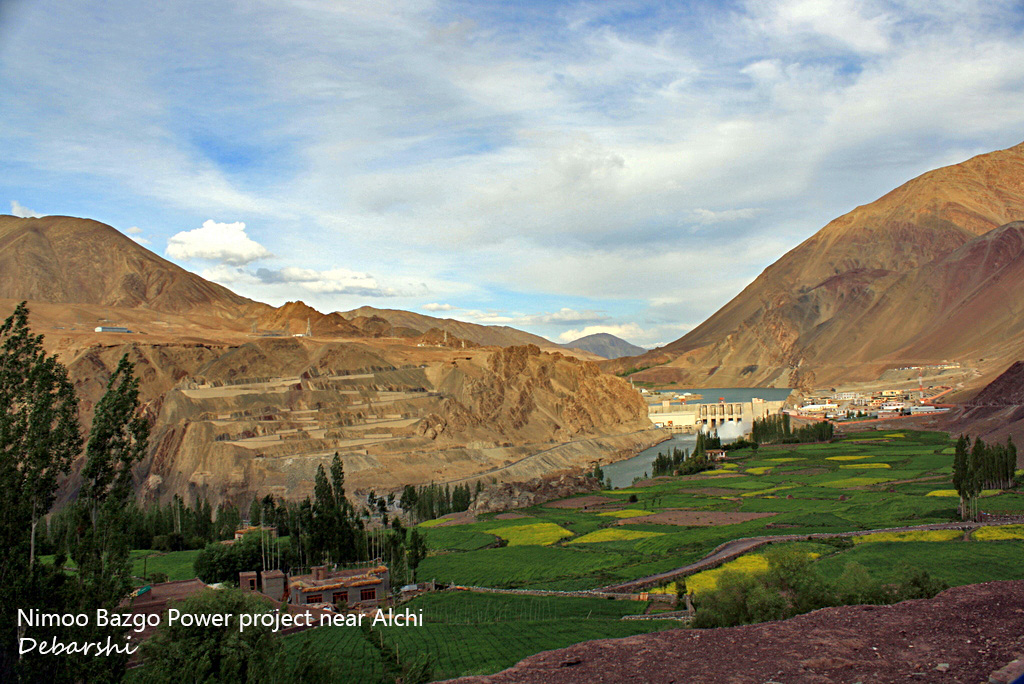
You will see the Assembly Hall or Dukhang, the Main Temple, the Manjushri Temple or Jampe Lakhang, Lotsabha Lakhang and Soma Lakhang , And of course the numerous Chortens.
The original intricately carved wooden gateway of the Dukhang is still well preserved, do note the Mahakal and the Wheel of Life .There is a pillared hallway leading to the Hall. The frescoes of Buddha, Mandalas, Bodhisattvas (reincarnations) and other celestial creatures adorn the walls.
There is also a three storied building built of loam & sandstone known as the Sumtseg supposed to be built in the 13th century. The textile paintings of the various deities – Maitreya, Avalokiteshwara and Manjushri are quite interesting.
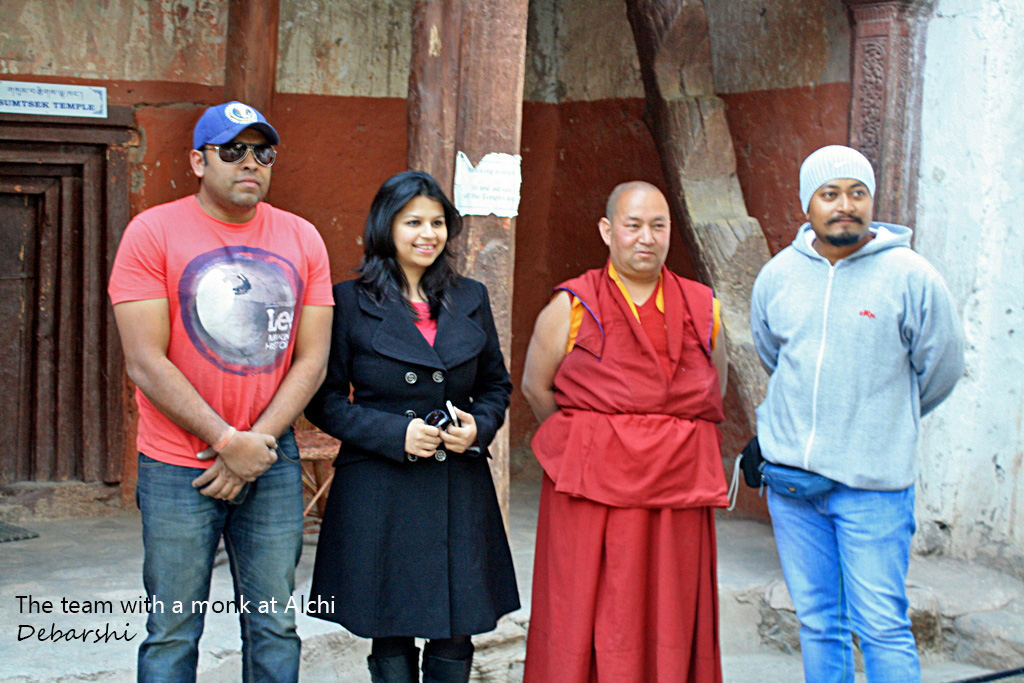
The Manjushri Temple or Jampe Lhakhang has 4 images of Manjushri back to back on a common high pedestal. All these images are single-headed but with four arms adorned with Bows & Arrows or a Sword or a book atop the Lotus.
A must mention here is the butter lamps, they are one of the most exquisite I have seen. You cannot take photos inside the temple lest the delicate frescoes get damaged.
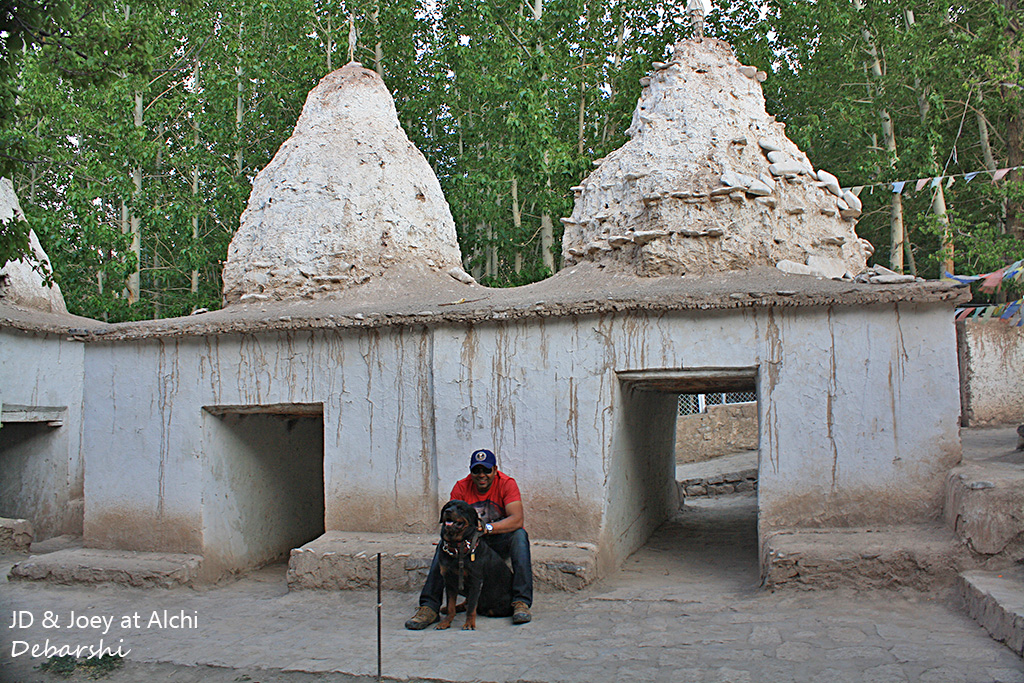
Likir
We visited both the Alchi & Likir monasteries the next morning from Leh. The colossal gilded statue of Maitreya stands at 23 meters and is visible from afar. Once you come back to the main highway, you need to take the road opposite and drive left to reach the monastery.
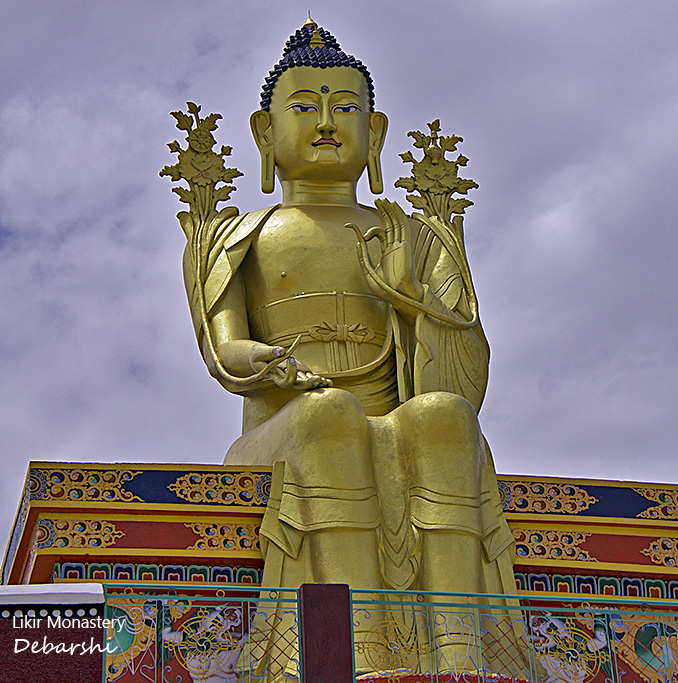
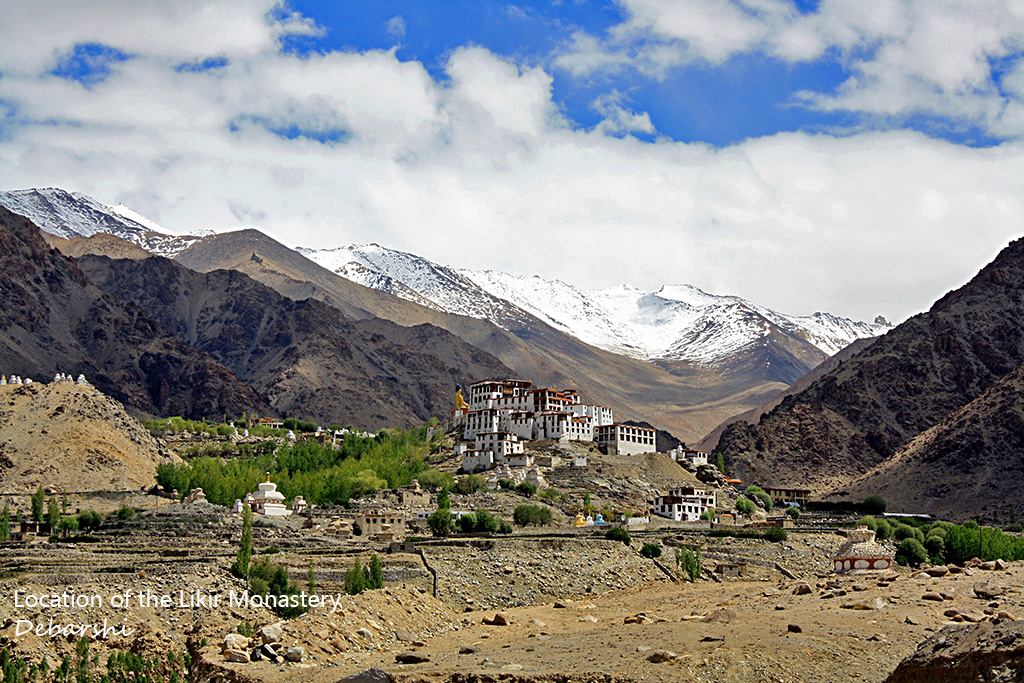
Likir is quite a prominent monastery today considering that the Ngari Rinpoche, the present Head is the younger brother of the Dalai Lama. This monastery is estimated to have been also built in the 11th century by the King Lhachen Gyalpo.
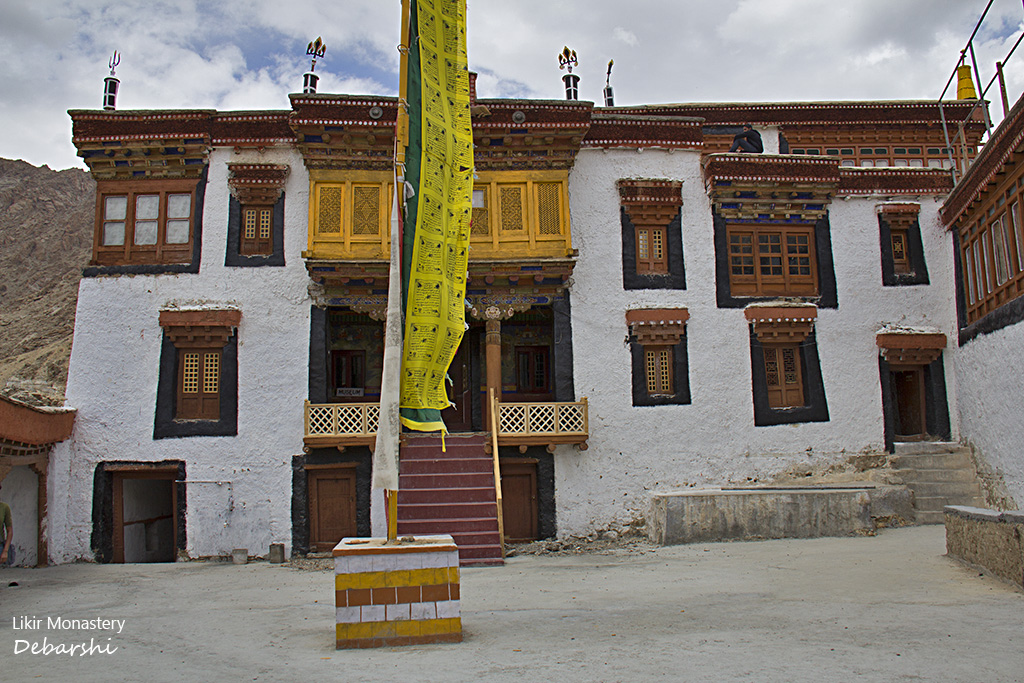
There are two Dukhangs or Assembly Halls with ornate Thangkas and glass bookcases filled with sacred Kangyur and Tengyur manuscripts. There are two rolled up huge Thangkas which are unveiled only during the annual festivals. You will also find stunning statues of Bodhisattva, Sakyamuni, Maitreya and Tsong Khapa. Also go into the other Dukhang to view Avalokitesvara image with 1000 arms and 11 heads.
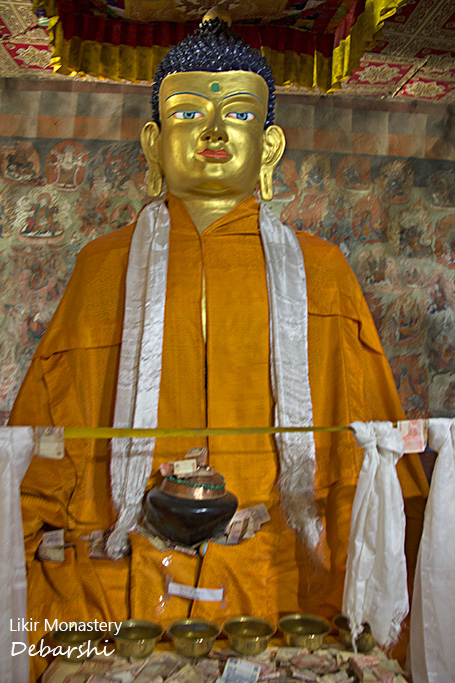
Do not miss the Guardian of the Four Directions on the gateway and the hand painted mandala of wheel of life in the Dukhang.
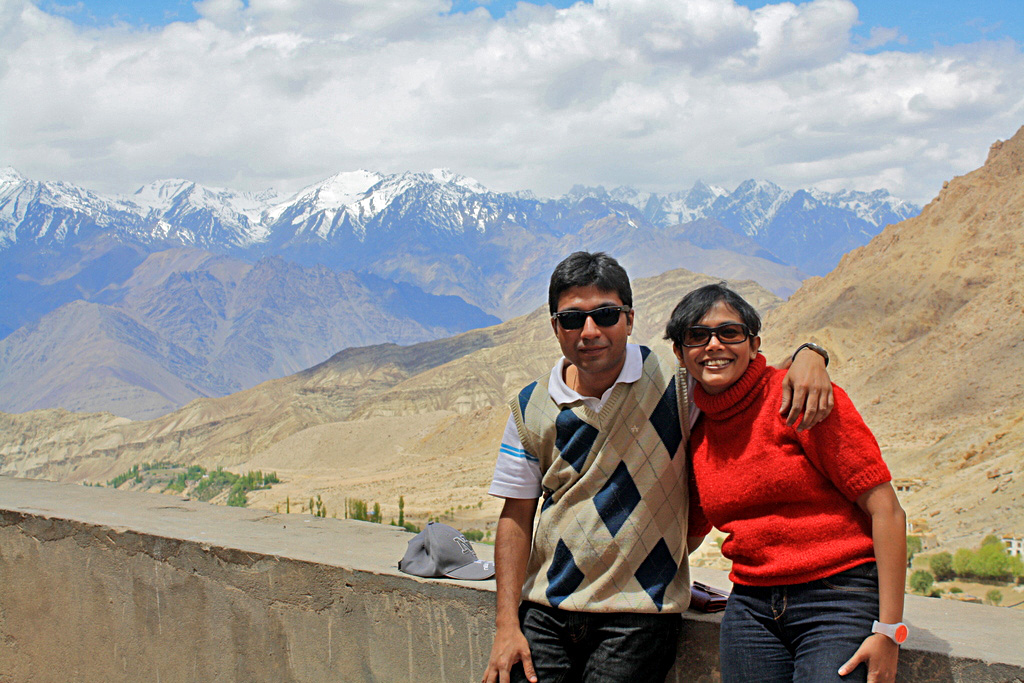
Today, the monastery has about 150 monks in the Yellow-Hat (Gelugpa) sect. We did see a number of student monks here and learnt that the Central Institute of Buddhist Studies runs a school here with subjects taught in Hindi, Sanskrit and English.
The Dosmoche festival is celebrated here annually in February.
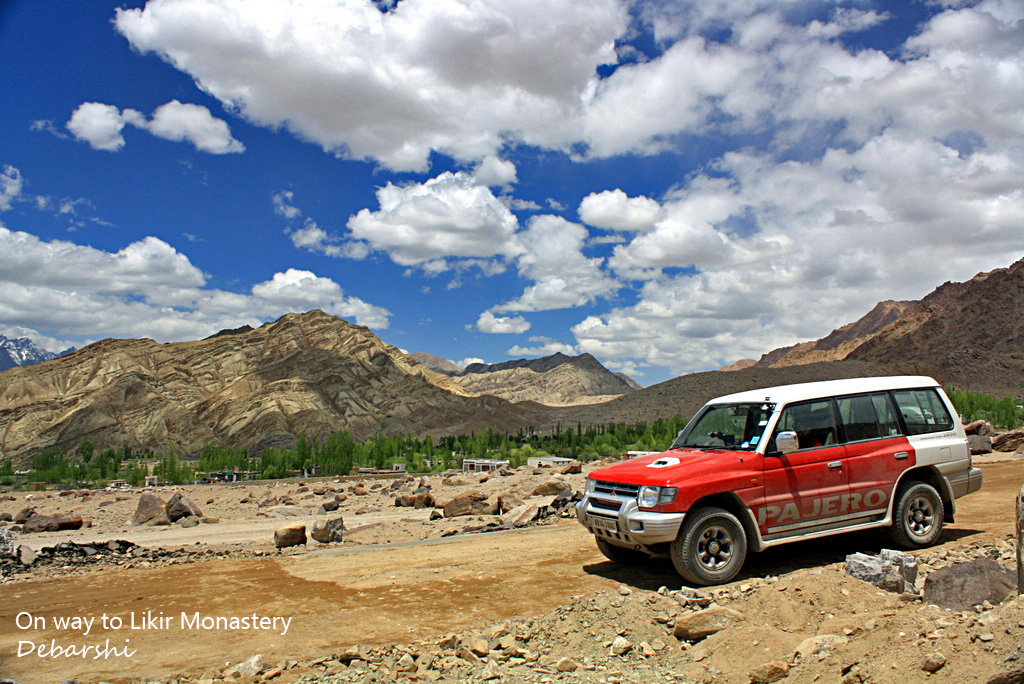
Video of the road that leads to the Likir Monastery and Basgo Monastery
Basgo
The Basgo monastery is more a fort than just a Gompa. We gave this a miss in 2012 but did visit in 2014. The path way leading to the gompa is incredible, a rugged surreal beauty.
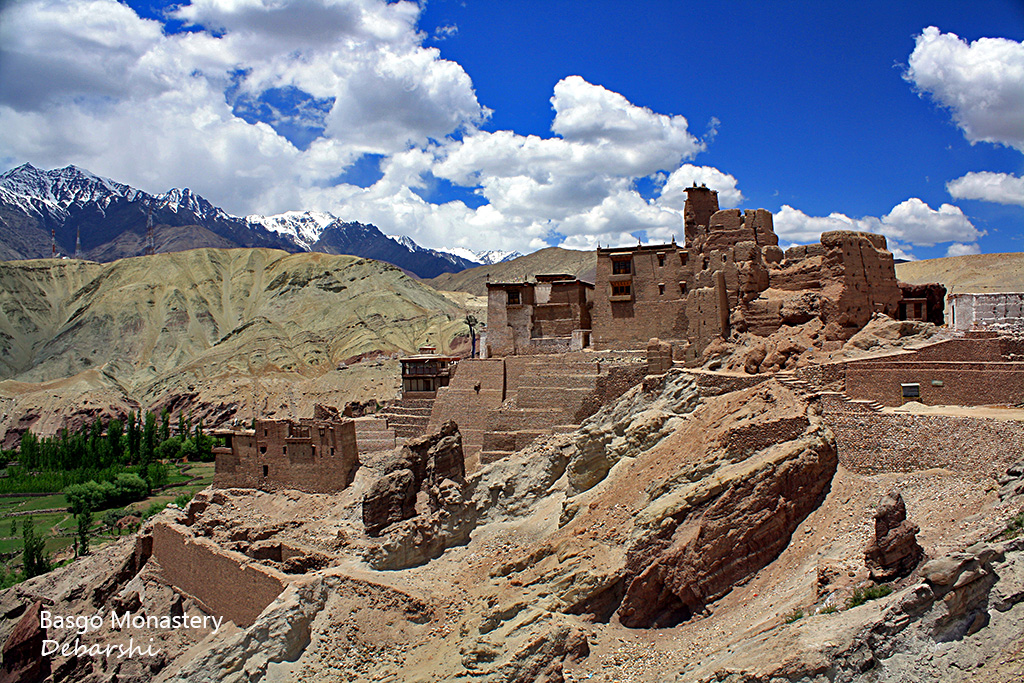
It is about 43 km away from Leh. In case you are driving down from Leh, you cross Nimoo, travel a little ahead and turn right and drive for about a km to reach the Basgo monastery. This was estimated to have been built by the Namgyal Dynasty in the 17th century. Historically, this impregnable citadel has withstood a 3 year long siege in the 17th century, but was later damaged in the ensuing Dogra Wars.
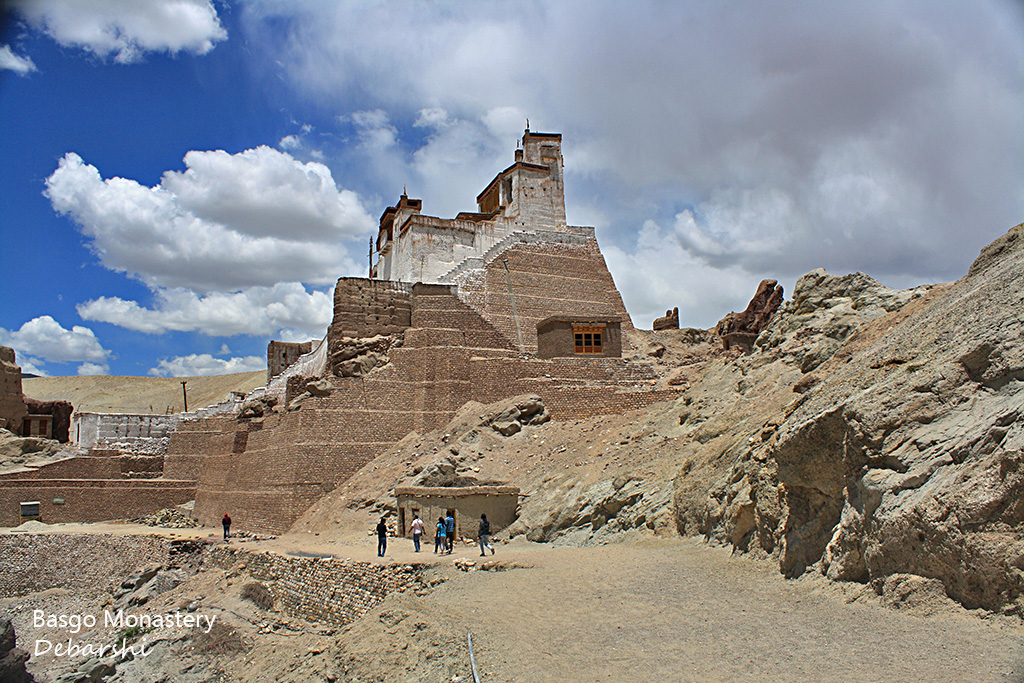
The structure is built of unbaked clay bricks and hence is quite delicate.
Basgo monastery comprises of the Citadel and Chambe Lhakhang, Serzing Lhakhang and Chan Chung.There is a monumental gold and copper statue of Maitreya Buddha standing at 45 feet. This statue is enlisted as an UNESCO heritage and one of endangered sites of the world. Also notable are the fabulous paintings, murals in the shrines and the gold and silver leafed sacred Kangyur and Tengyur manuscripts.
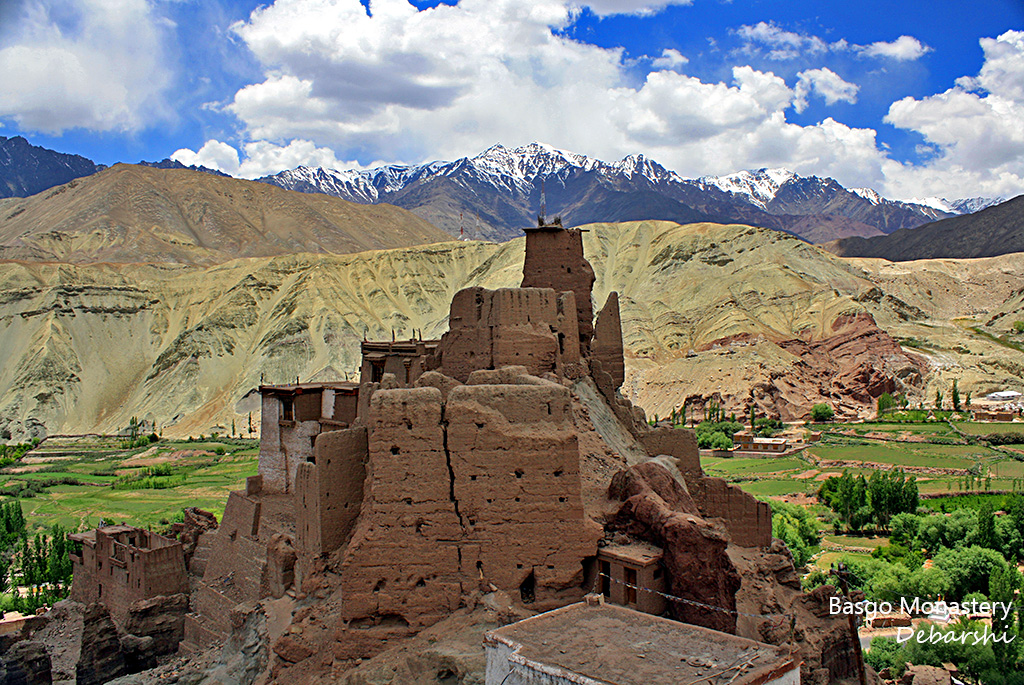
Joey, our friend JD’s Rottweiler who travelled with us was very popular among a group of school kids there and posed with them.
Leh Palace
This monument is in the Leh city, in the old Leh town. It was planned on the Potala Palace in Lhasa, Tibet and built in the 16th – 17th century by King Sengge Namgyal.
The Palace is a nine storied building – the upper floors housed the royal family while the lower floors served as stables and servants quarters. Today it is quite in a state of ruin and is being maintained from crumbling by the Archaeological Survey of India (ASI).
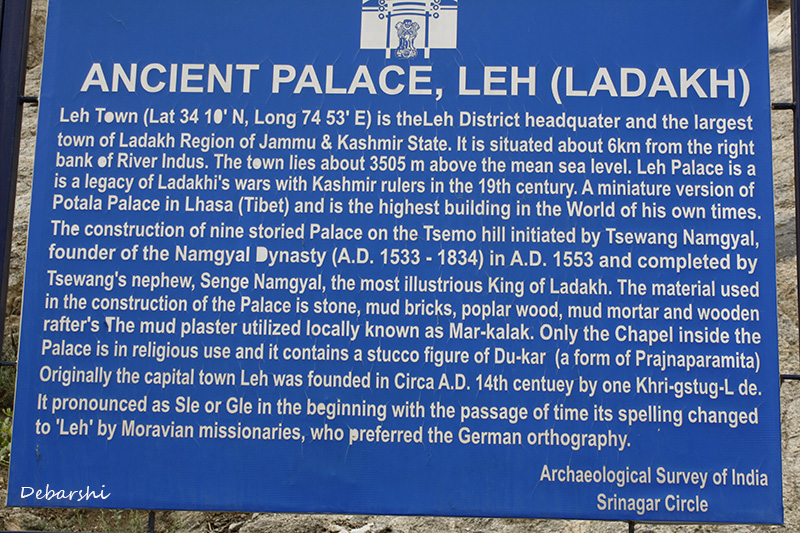
The structure is immense but the external façade looks quite drab. The palace was constructed from stone, bud bricks, poplar wood, mud mortar and wooden beams. It is plastered with mud locally known ad Mar-kalak. The palace gateway is adorned with wood carvings.
The larger rooms and hallways have been converted into exhibition halls. Ancient Tibetan thangkas with intricate designs and brilliant colors are exhibited in these hallways. It is said that these colors were derived from powdered stones and gems. The museum was closed when we reached, but there is a collection of royal memorabilia like crowns, ceremonial dresses and jewelry. There is functional temple in the Palace with a stucco figure of Du-Kar.
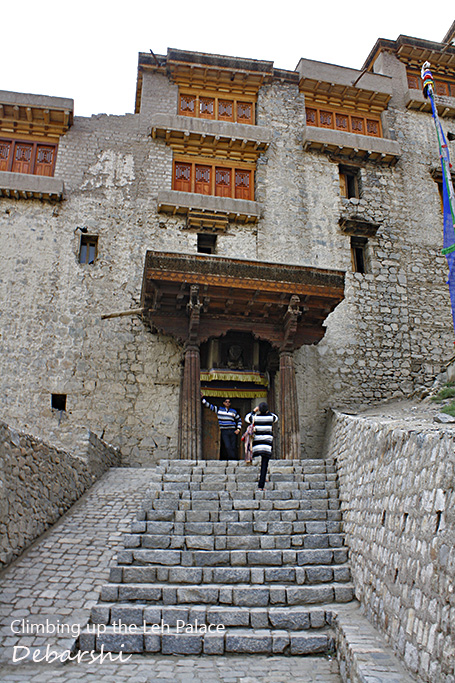
You can reach the terrace ascending up the steep stairwell. This is an absolute no miss.The panoramic view of Leh and the views of the Stok Kangri range are stunning.
The Palace is open from 7.00 AM to 4.00 PM. Entry fees per head for SAARC citizens is INR 15 and for foreign nationals INR 100.
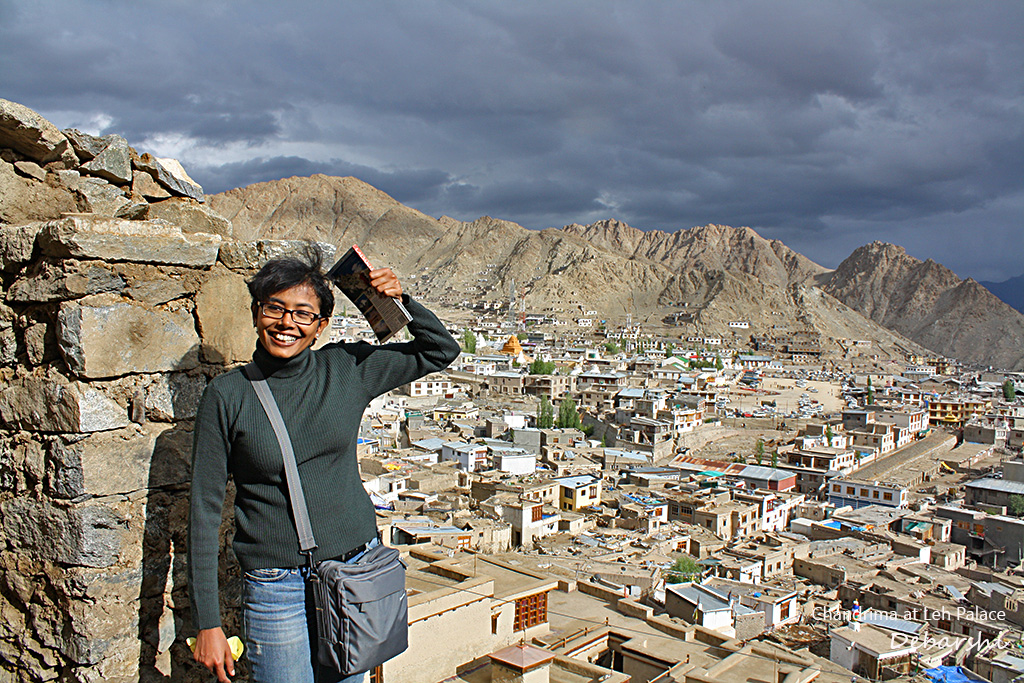
Spituk
This gompa is just about 6 -7 km from the Leh City at an altitude of 3,307 meters. Once you cross the airport, turn left and you will reach the base of the Gompa in half a km.
Spituk was founded by the Red Hat (Kadampa) sect in the 11th Century, although was taken over by the Yellow Hat sect in the 15th century. Today, the gompa has been restored and several tiers have been added.
The notable features are the Assembly Hall – Dukhang which is adorned with Tibetan thangkas, masks and religious scriptures; the temple of Tara – Dolma Lhakhang; Mahakal Temple with the statue of Vajrabhairava (covered) and the giant Kali statue (also covered).There is also a throne for the Dalai Lama and multiple images of Buddha, Bodhisattvas and Tsong-kha-pa.
Other than the summers, you can also visit during the annual Spituk Festival also known as the Gustor Festival. The statues covered through the year are shown to the public at this time.
You get a panoramic view of the Leh Airport and the Indus River.
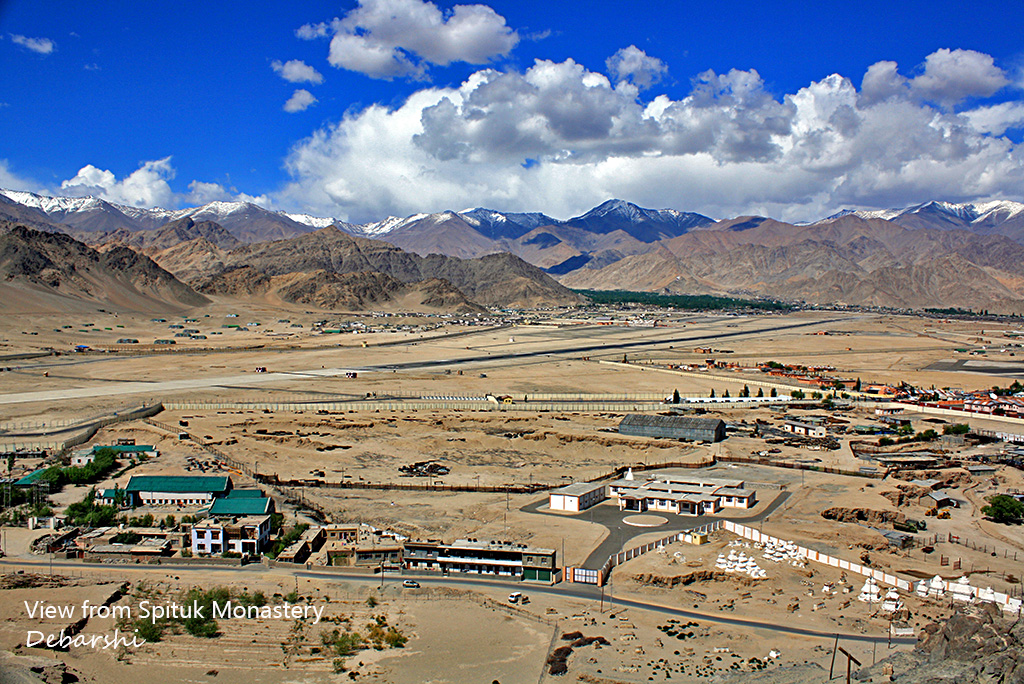
Shey
The Shey Palace and Gompa are situated about 12 km from Leh on the Leh – Manali Highway atop a small hill. One of the most hallowed monasteries today, Shey gompa houses a monumental gilded copper Buddha statue. Shey was the summer capital of the royal dynasty and the gompa was probably built in the 17th century by Deldon Namgyal. We saw this from the highway enroute to Manali, but did not stop here.
Thiksey
The Thiksey monastery is about 19 km from Leh also on the Leh – Manali Highway. The approach road from the valley passes through the east side of the Thiksey Monastery’s main building and you can drive up to this level. The lower level has a statue of the Tibetan deity while the highest level has a chorten.
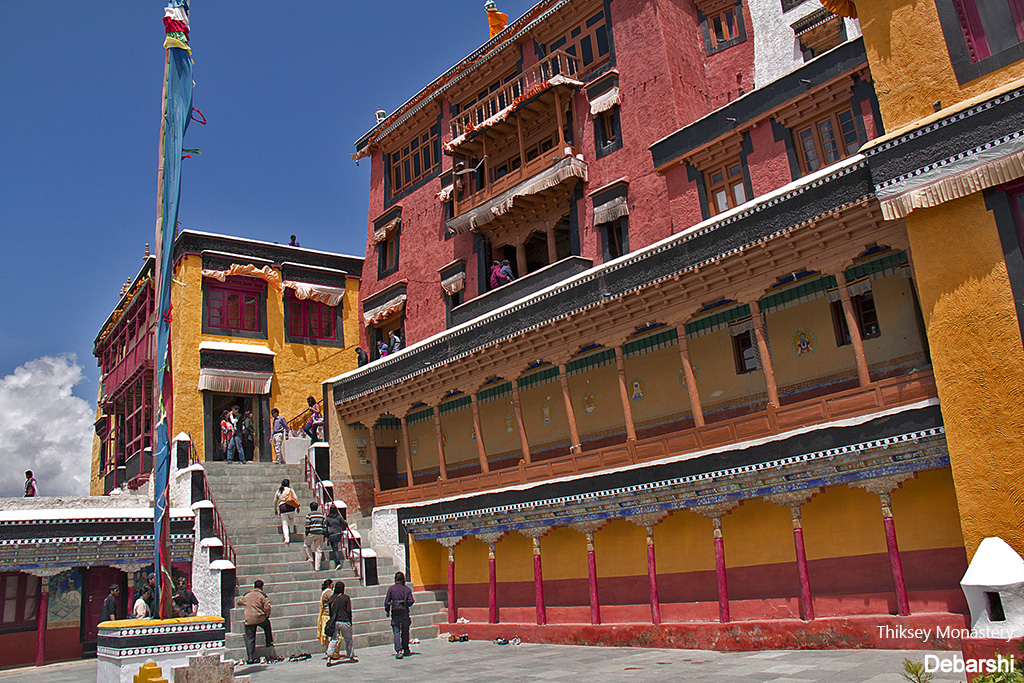
This too resembles the Potala Palace in Lhasa, Tibet. The gompa has 12 storeys, 10 shrines, assembly hall and a separate set of buildings for the nuns. The buildings are in a hierarchal order.
The most remarkable element in this gompa is the 15 meters high statue of Maitreya over 2 floors in the seated lotus position. This was built to commemorate the visit of the then Dalai Lama in 1970.
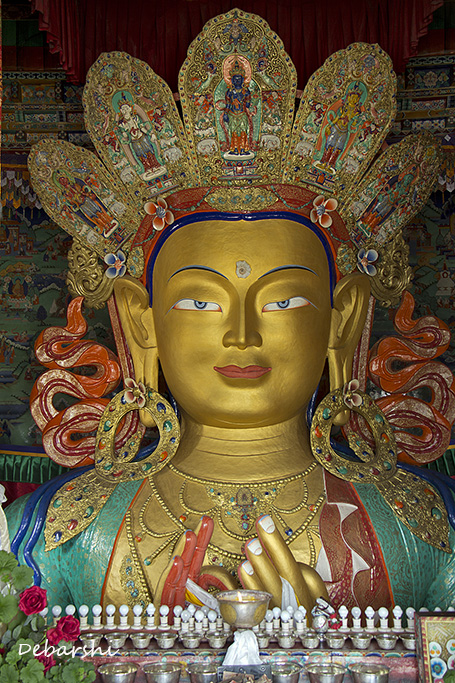
The Dukhang is covered with many murals of the Tibetan calendar with the the Wheel of Life and Thangkas. And then the Tara Temple dedicated to the Goddess with 21 images of the deity.
Thiksey is perched at an altitude of 3600 meters and gives a panoramic view of the Indus Valley and nearby Stok & Shey monasteries.
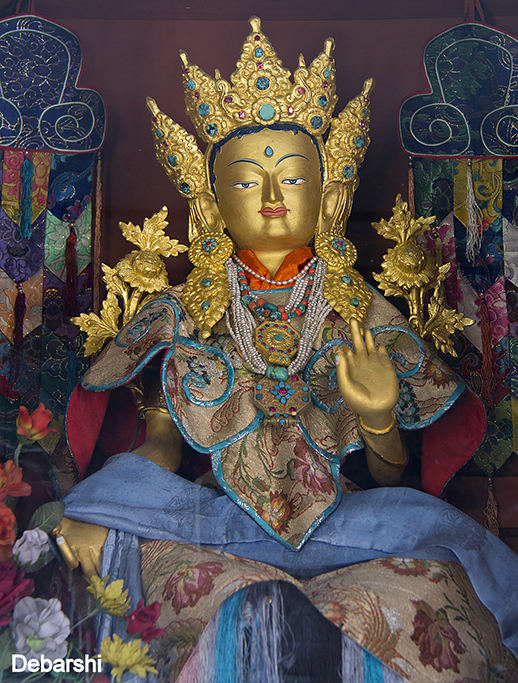
Hemis
The Hemis Monastery belongs to the Drukpa Lineage and is about 41 km from Leh on the Leh – Manali Highway. The highway forks in Karu one moving towards Pangong Tso and the other towards Manali. Travel on the Manali fork and then turn right crossing the Indus River driving on for another 6 km.
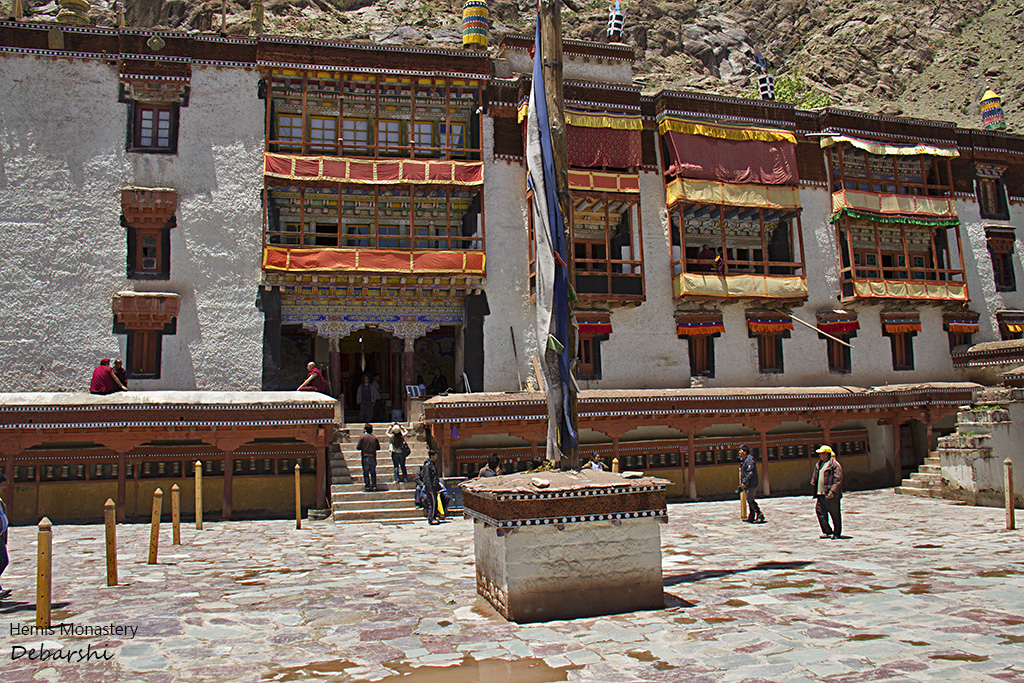
What will strike you once, you enter this gompa is the air of magic. The monastery is probably one of the richest ones in India. Divided into two sections – Assembly hall or Dukhang and Temple or Shogkhang.
Hemis has staggering collections of ancient relics, Buddha statue, stupas made of gold and silver, Frescoes in the courtyard ,Thangkas, sacred Kangyur and Tengyur manuscripts and a few exhibited in the museum with an entry fee of Rs 100/- per head .
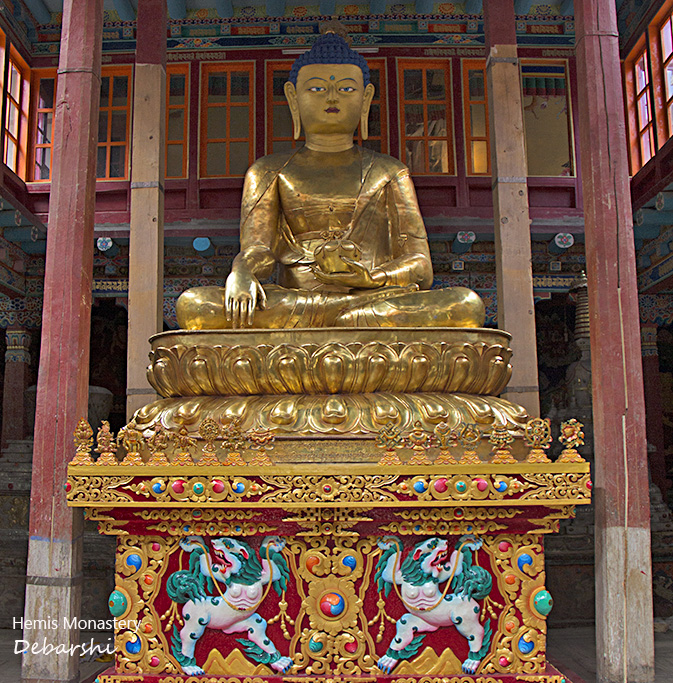
I had read about two intriguing facts and in 2014 visited the museum to view this.
-
A noted Russian journalist Nicolas Notovitch was recuperating in Hemis in 1894. He had written about Hemis being the origin of the Life of Saint Issa, where Jesus supposedly was in India during his lost years.
-
In 1922, Swami Abhedananda while walking across the Himalayas also rested in Hemis and claimed to have discovered the manuscript on the lost years of Jesus. He later wrote about this in his book Journey into Kashmir & Tibet published by Ramakrishna Vedanta Math.
Unfortunately no such manuscript is displayed in Hemis. One monk did tell me that all manuscripts are kept in their inner vault not for the public. Even if you cast this mystery aside, Hemis is a must visit monastery for its ethereal beauty.
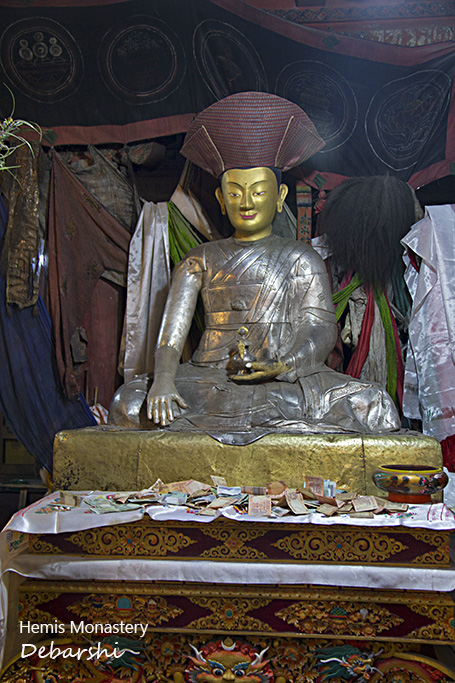
The gompa also hosts the famous annual Hemis Festival in June for 2 days to celebrate the birth anniversary of Guru Padmasambhava.
Diskit
This monastery is quite far from Leh, it is located in the Nubra Valley. It is about 12o km from Leh and you would cross the Khardungla Pass to reach the Nubra Valley.
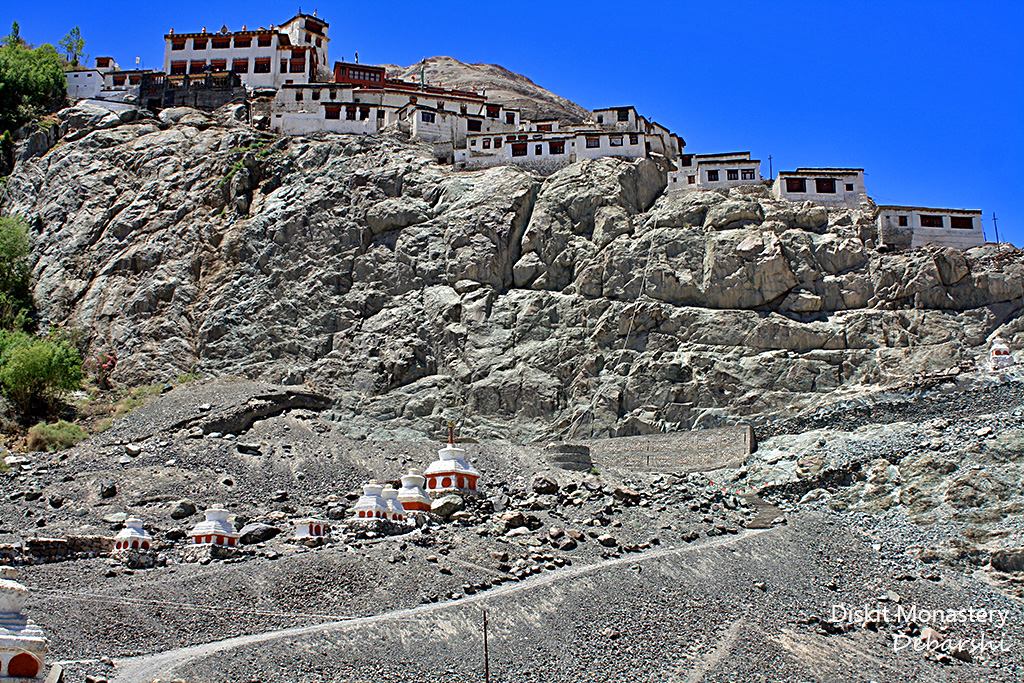
In the 2012 journey, we could not cross Khardungla as it was snowing heavily. The Indian army personnel stopped us in South Pullu. In 2014, we were lucky to be able to cross the pass and drive down to Nubra & Hundar. The gompa is on the top of a hill overlooking the Shyok river valley.
The colossal statue of Maitreya Buddha standing 106 ft tall defines Diskit. The Dalai Lama inaugurated the statue in 2010.
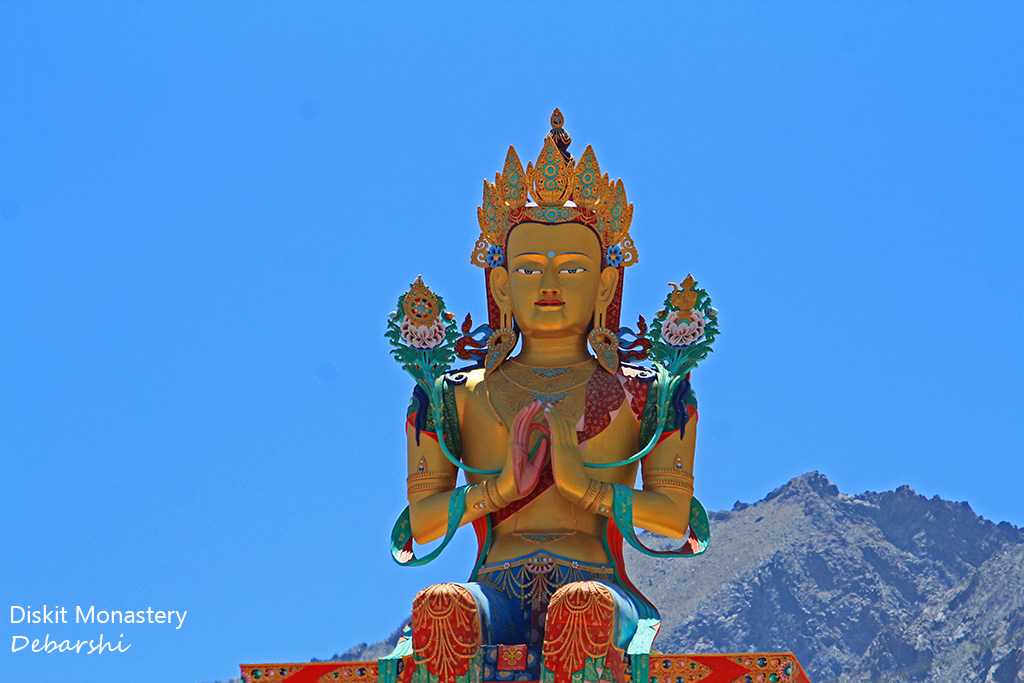
The monastery also runs a school and currently has about a 100 or so monks. We did not climb to the top of the monastery though via the steep flight of stairs, but I recommend visiting the gompa.
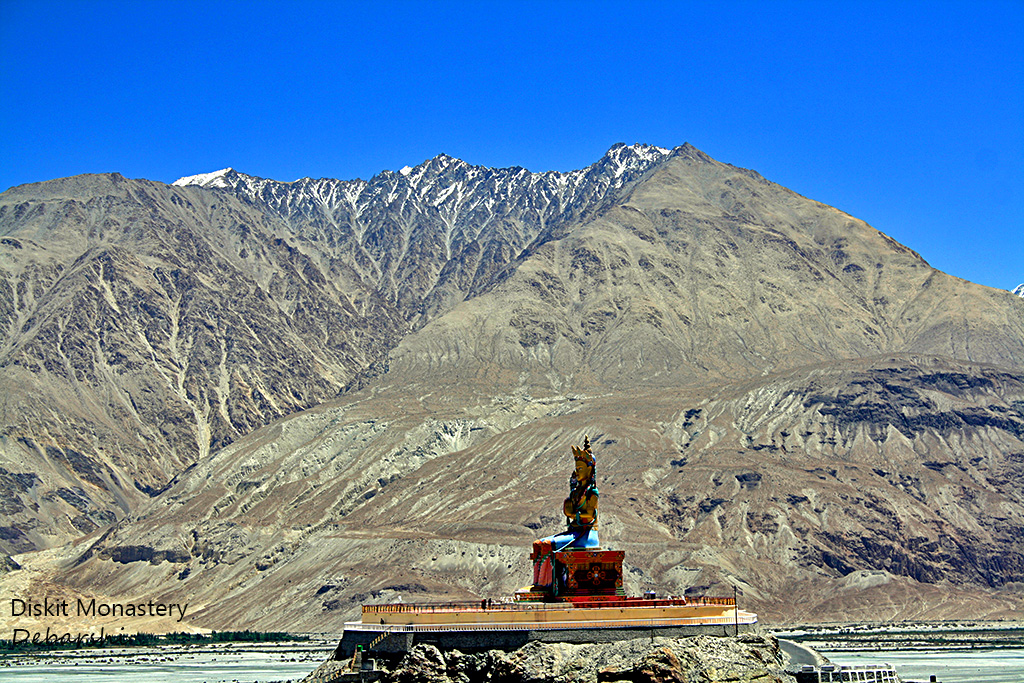
Dosmoche is celebrated annually in winter . The entire valley is isolated from the world during the cold season. The villagers from the entire Nubra Valley participate in Dosmoche.
Chemrey
We saw this monastery on our way to Pangong Tso before the Chang La. Chemrey is about 44 km from Leh. After about 33 km on the Manali highway, you will come to a fork in Karu. Once you turn left on the Pangong road, you can drive for another 7 km and then a left turn of 3 km will bring you to the Gompa. There is a strikingly tall statue of Padmasambhava apart from the colorful frescoes.
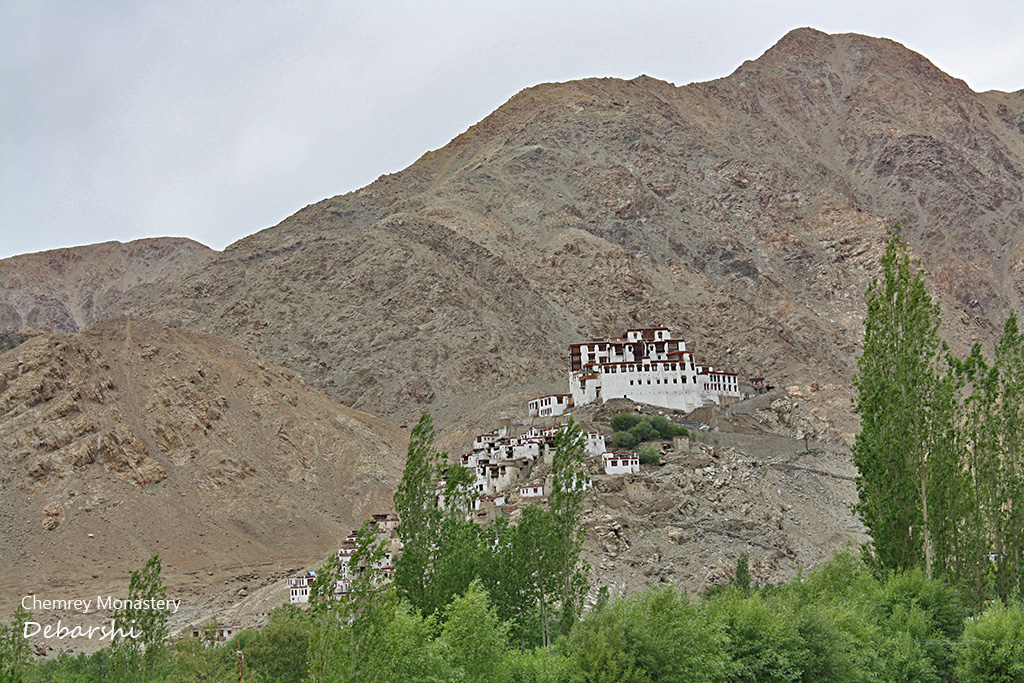
A Few Do’s and Don’ts
- The gompas do not prescribe any particular dress code for visitors.
- Taking off your shoes is mandatory, you can keep wearing your socks since the floors will be cold.
- You should absolutely refrain from touching any of the relics like the frescoes or Thangkas
- You should not take any photo with your back towards the deities or take any photo of the monks without asking them.
- Do not disturb the lamas in prayer. Feel free to talk to the monks who are moving around. They are fluent in English and are happy to talk about the gompa. A few also enquire about technology and your hobbies.
- Some gompas (Alchi) do not allow photography inside to prevent damage to the frescoes, be respectful of that.
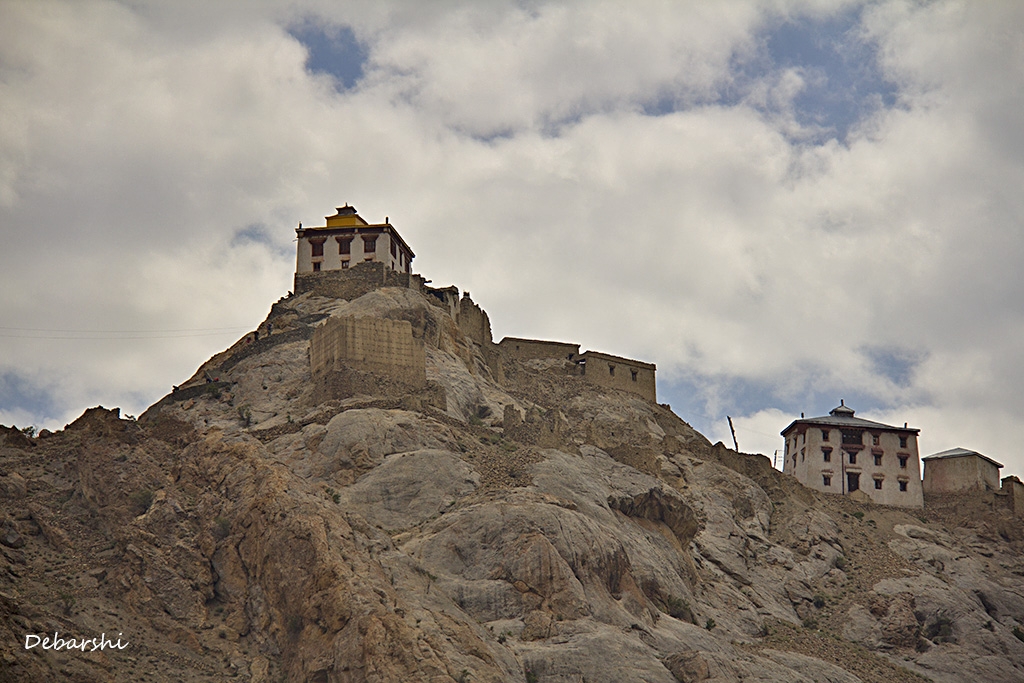
What will you find in the monasteries?
Buddha
Of course, the monastery will have the universal image of Buddha albeit in various avatars. The most commonly found is Maitreya – the future Buddha and the historical Buddha, Sakyamuni
You may also see the 5 Dhyani Buddhas in many frescoes – Vairochana, Akshobhya, Ratnasambhav, Amitabh and Amoghasiddhi symbolizing the cosmic universality in Buddhism.
Bodhisattva
The Bodhisattvas are the incarnations of Buddha. Of course, the monastery will have the universal image of Buddha albeit in various avatars. The 3 main ones are Manjushri (Symbolizing Wisdom) Avalokiteshvara (Symbolizing Compassion) and Vajrapani (Symbolizing Power) Not just in Ladakh, but also across India (e.g.: Ajanta caves).
The Dalai Lama is the living incarnate of Avalokiteshvara.
Prajnaparamita
She is the Mother Goddess in the Mahayana School of Buddhism . Praying to Prajnaparamita help you gain wisdom.
Tara
Tara is a female Bodhisattva born from the tears of Avalokiteshvara. She blesses her devotees with wisdom , merit , compassion. Vajrayana Buddhist followers pray to her with the chant oṃ tāre tu tāre ture soha.
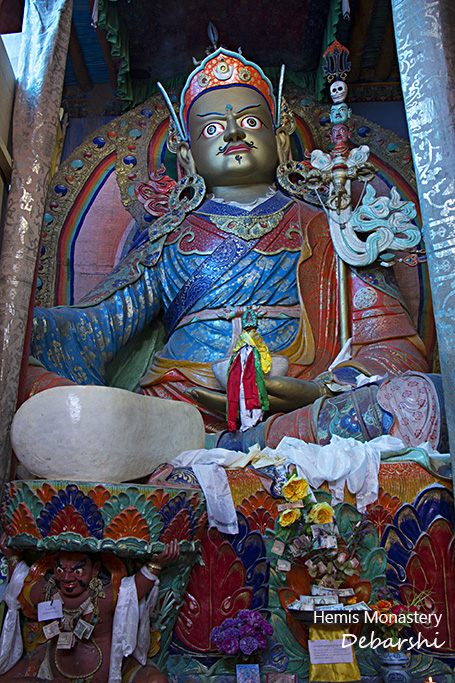
Guardian Deities
You will find these formidable looking deities in almost all the gompas like the Vajrabhairava or Mahakal. They are generally darker in color and do a garland of human skulls.
Lords of the Four Quarters
The frescoes and the carvings in the monasteries of the four Lords signify the 4 directions. Kuvera, Lord of the North; Dhritarashtra Lord of the East; Vimdhaka, Lord of the South and Virupaksha, Lord of the West.
Dharma Chakra or Kaal Chakra
The entrance also has the Wheel of Life or Time.
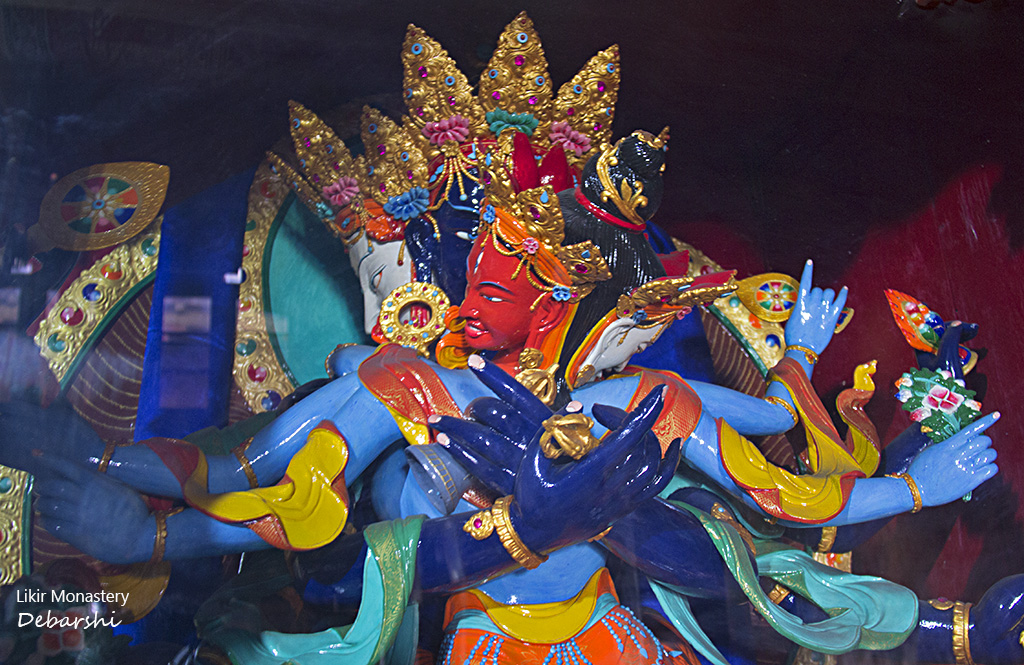
How to Reach Ladakh
Air
To visit the Monasteries in Ladakh you have to reach the region around Leh. There are direct flights today from Delhi, Mumbai and Srinagar to Leh daily arriving at the Kushok Bakula Rinpoche Airport. All flights arrive and depart only in early mornings. This airport is one of the highest commercial airports at 3256 meters above sea level.
Road
We have driven down to the Ladakh region from Kolkata in 2012 and 2014. We entered the Ladakh region through the Kashmir valley via Srinagar, Kargil and returned through the dangerously beautiful Leh Manali Highway. The road needs a special mention here. We crossed the famed and treacherous Zojila pass on the way from Srinagar to Kargil. Needless to mention, the ascent is steep with almost no road surface. Once you drive through ice walls on top of the pass, you reach a valley on the other side where a world awaits you more stunning than you can imagine.
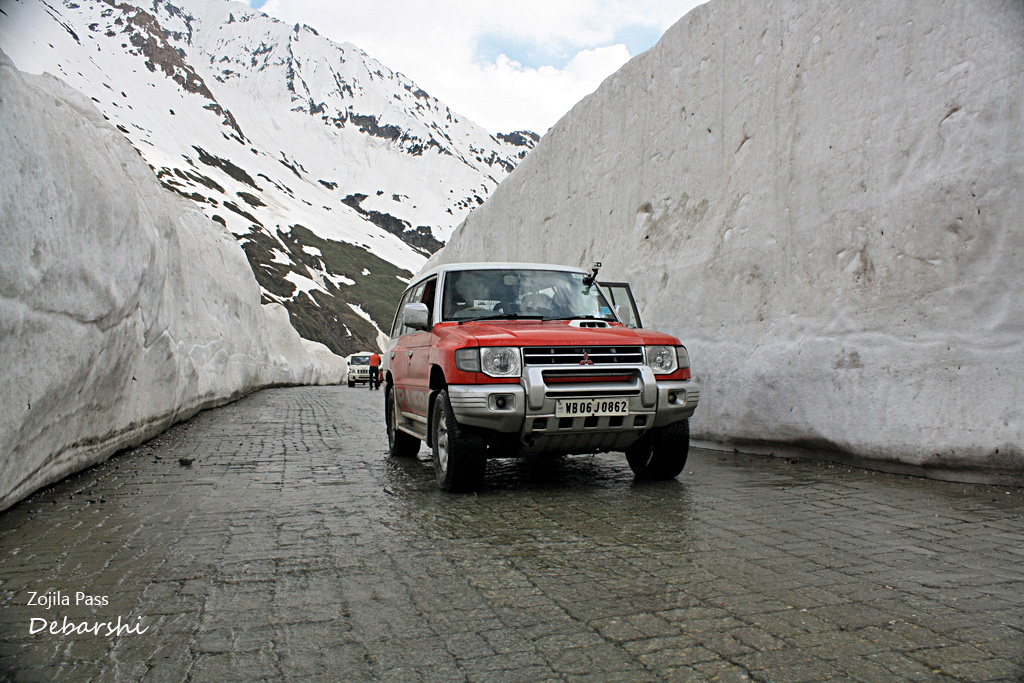
Walls of ice cut through for roads at Zojila
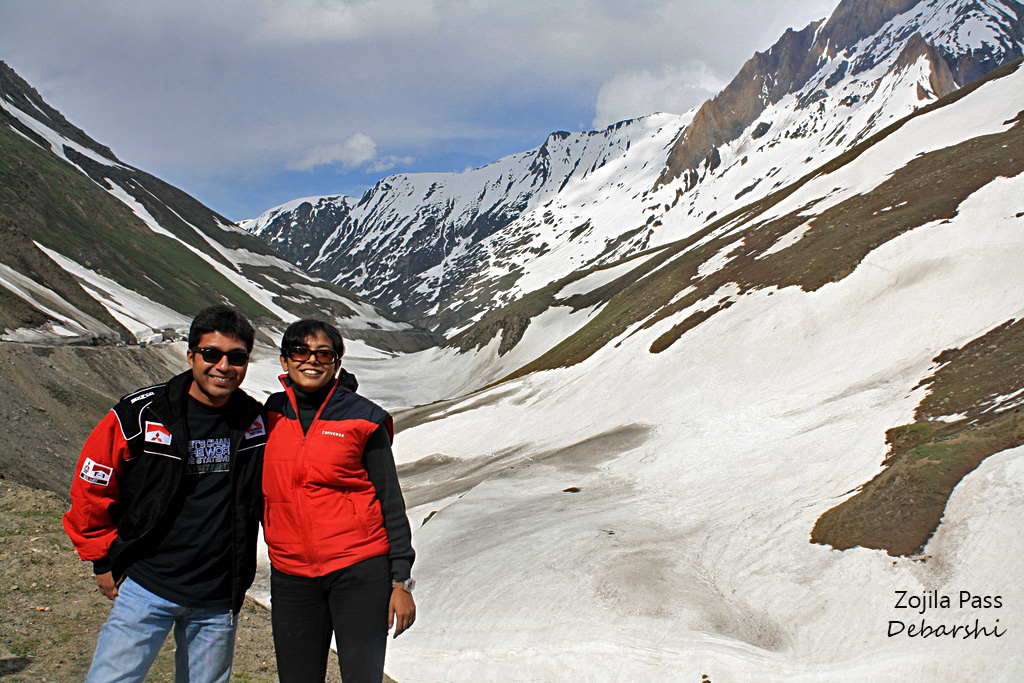
On top of Zojila
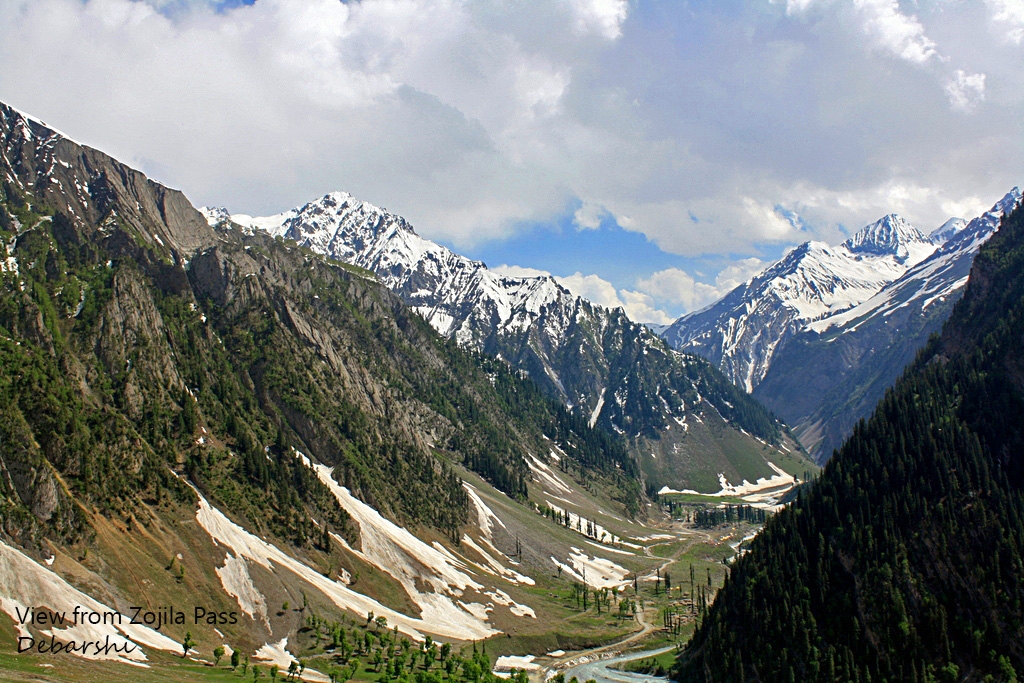
View from Zojila Pass
You will also cross two notable places – Drass (2nd lowest recorded temperature globally) and Kargil War Memorial maintained by the Indian Army. The road on the way to Kargil has a section completely exposed to the enemy shelling positions from the Line of Control quite close to the Tiger Hill. In 2012, the Commanding officer joined us for a cup of tea and momos in Kargil.
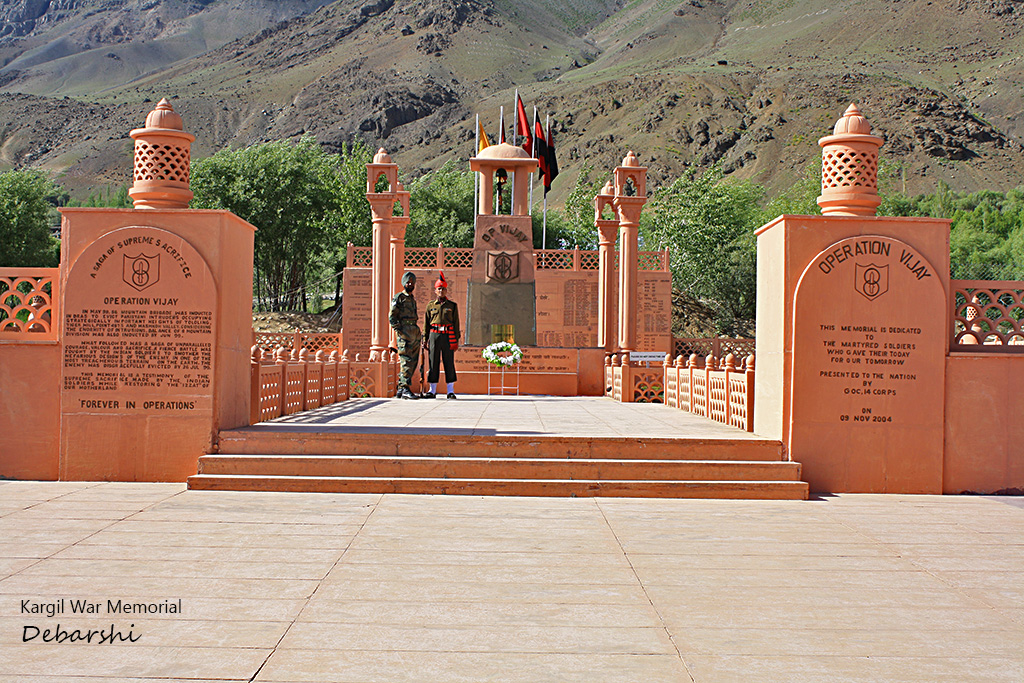
The Kargil War Memorial every Indian should visit and be proud of
For visiting the Monasteries in Ladakh one has to travel through roads which are not only beautiful but dramatic. The road from Kargil to Leh is quite remarkable in landscape as well as covers a number of monasteries. You will cross the Namika La at 3720 meters and the Fotu La at 4108 meters. There are exceptional views of the Moonland formation like the surface of the moon in shape and color created after the drying up of a lake. There is also the confluence of the Indus & Zanskar Rivers at Nimoo, the immense Basgo plains and the Magnetic Hill (only one of two in the world).
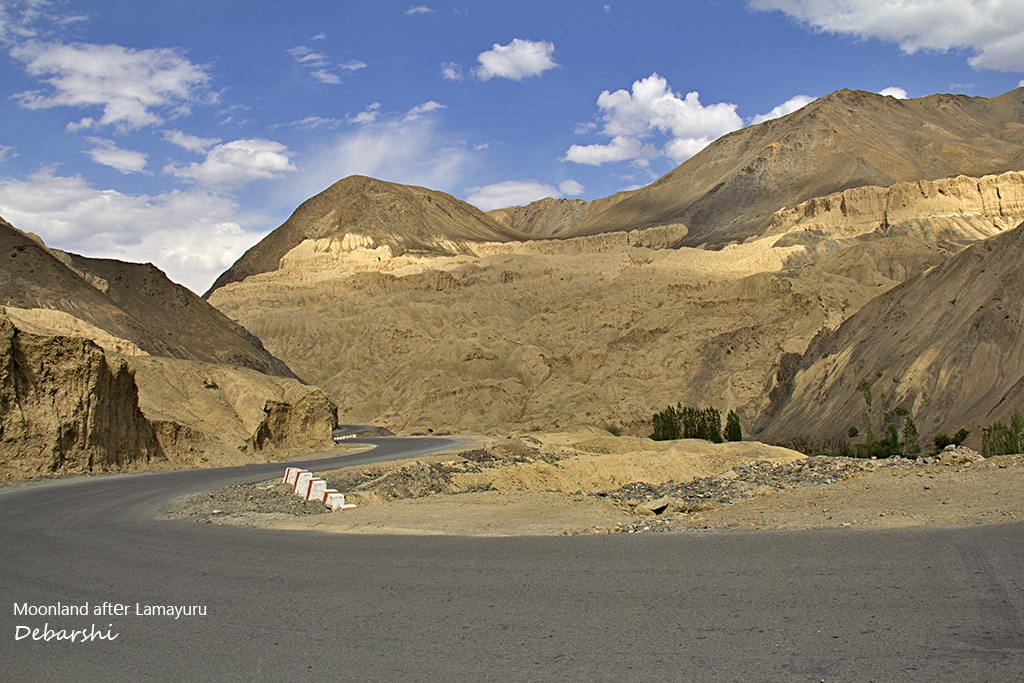
Road winds through moonland after Lamayuru

Muddy water of Zanskar meets the Turquoise waters of Indus at Nimmo
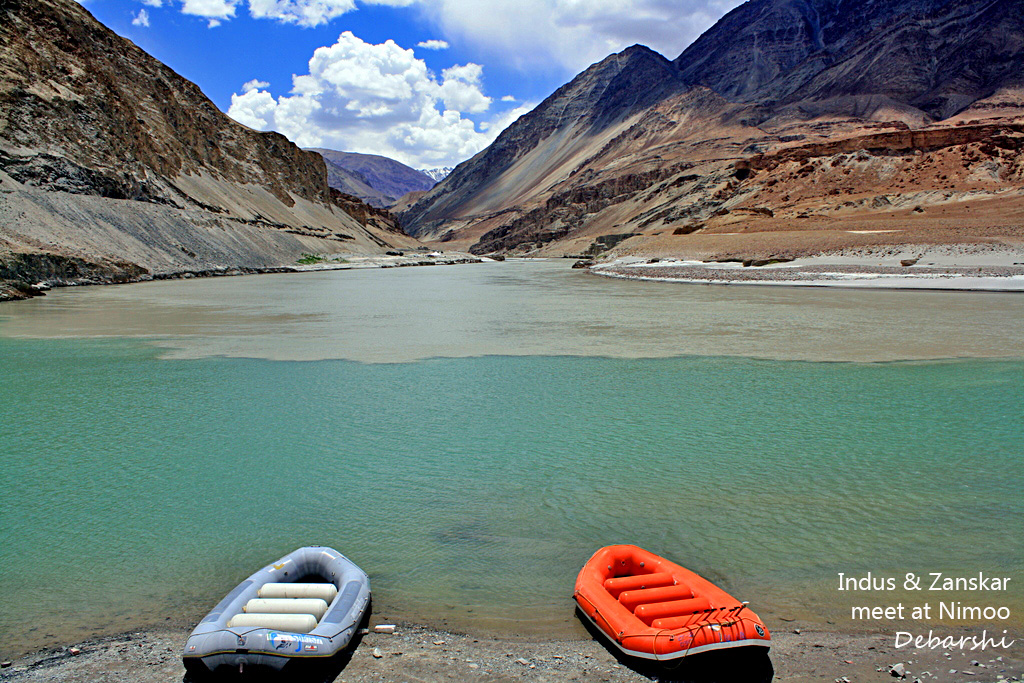
Boating at the confluence of Indus and Zanskar
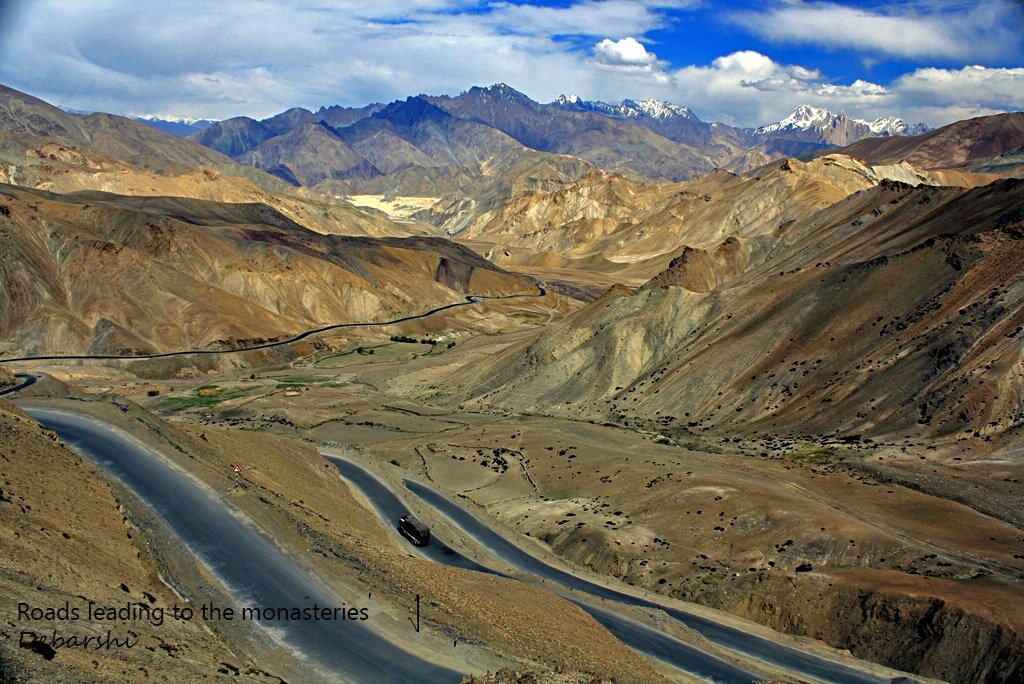
Roads winding down a mountain pass
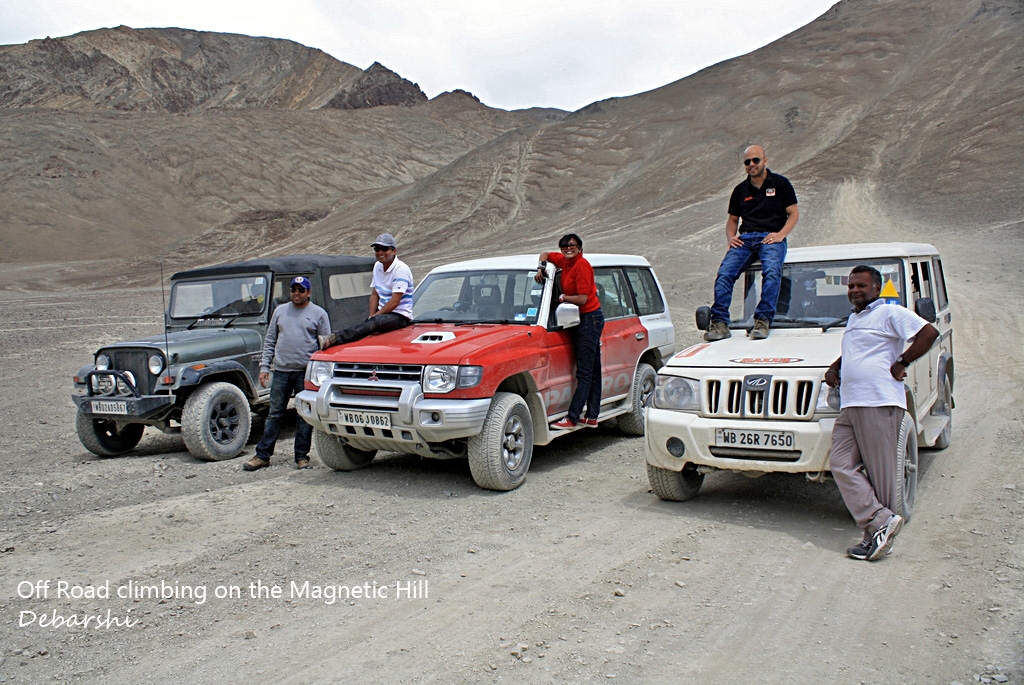
After a round of off-roading at Magnetic Hill
Ladakh is of course is home to dreamlike beauty of the Himalayas and away from the humdrum of urban lives. A visit to Ladakh once leaves you begging for more.
The memory of the dimly lit Dukhangs illuminated by a single sun ray, the ancient frescoes with still a hint of the brilliant color, the striking opposites of the vicious looking guardian deities against the tranquil faces of the Bodhisattvas, the overpowering aroma of the incense and the universal chanting of the sacred mantra Om Mani Padme Hum (hail the jewel in the lotus).
We have not covered all the monasteries in Ladakh and are keen to go to Karsha & Phugtal in Zanskar, but we will return to this Himalayan Paradise for another slice of mysticism.
